Respiratory Season











Last month, I wrote about the value of relationships in all walks of life. This month let’s put those relationships to use by preparing your clients for the upcoming respiratory season.
Back in my day we started school after Labor Day, but here in Georgia the kids have been in school spreading germs since August 8. Which means for them and the rest of us, cold, flu, strep, RSV, and COVID season has officially kicked off before we’ve seen one down of football.
The moral of this story is prepare, prepare, prepare …
Each year when we interview the diagnostic companies – Abbott, BD, Cepheid, QuidelOrtho, and Sekisui – they always tell us the same thing. Please tell your readers to get their caregivers prepared for the season. Hopefully, your clients haven’t forgotten the lessons of 2020, but in case they have, now’s the time to use your caring relationships to remind them “Winter is Coming,” and so is respiratory season.
We have a wonderful relationship with the five companies I listed above. Each of them supports distribution and reps in every way possible. This year’s cover story and accompanying supplement are designed to prepare you and your customers for the season ahead. Please take the time to read it for yourself, but also to forward it to your customers. One of the easiest ways to share any article in Repertoire is through the RepConnect app. Simply go into the app and click on the issue, and then find the article you’d like to share. From there, click the quick share button and your email will auto populate, allowing you to share our content with your clients. This not only helps to educate them, but also shows them they are working with a sales professional who cares enough to send them content to better their skills and practice. I realize this seems like a simple thing, but I would chalk it up there as impactful as a handwritten note. By taking the time to help educate them, you are delivering real value as well.
Building relationships takes time and trust. What better way to build trust than caring enough for your client to share great content from amazing manufacturers that support you day in and day out. Please support these five organizations the way they support you through this content and with their sales organizations.
In closing, I would like to say, “It’s Selling Season,” so “ROLL TIDE,” let’s go kick some … Good luck over these next few months. Just remember, it starts with prepare, prepare, prepare!
Dedicated to the Industry, R. Scott Adams
editorial staff editor
Mark Thill mthill@sharemovingmedia.com
managing editor
Graham Garrison ggarrison@sharemovingmedia.com
editor-in-chief, Dail-eNews
Pete Mercer pmercer@sharemovingmedia.com
art director
Brent Cashman bcashman@sharemovingmedia.com
circulation
Laura Gantert lgantert@sharemovingmedia.com
sales executive
Amy Cochran acochran@sharemovingmedia.com (800) 536.5312 x5279
publisher Scott Adams sadams@sharemovingmedia.com (800) 536.5312 x5256
founder Brian Taylor btaylor@sharemovingmedia.com

Subscriptions www.repertoiremag.com/subscribe or (800) 536-5312 x5259
Repertoire is published monthly by Share Moving Media 350 Town Center Ave, Ste 201 Suwanee, GA 30024-6914
Phone: (800) 536-5312, FAX: (770) 709-5432; e-mail: info@sharemovingmedia.com; www.sharemovingmedia.com

Why reps must be mindful of the challenges customers face when they commit to a moderate complexity lab.
CLIA should be on the minds of every distribution account manager who has helped his customers implement a CLIA moderate complexity or high complexity lab. Well managed, these point-of-care labs provide exceptional value to both the patient and the care giver. With needed lab information available during the patient visit, a treatment program can be initiated or modified with confidence, saving time and providing better quality of life and improved health outcomes for the patient.
While that is all true, a poorly managed physician office lab can be inefficient, produce less than satisfactory patient results and create frustration for both the care givers and their lab staff. Concerns about CLIA compliance are a key factor in customers deciding not to embrace lab testing in their office or discontinuing testing down the road.
As of 2021, there were over 34,000 CLIA moderate or high complexity labs operating in the physician office market. This number is a

tribute to the recognition of the value of onsite testing by the provider community as well as your efforts to educate your customers on the importance of lab testing while providing consultative assistance in establishment and maintenance of high quality physician office labs. It is not an easy task.

As proof, in 2021, CMS reported it found over 18,000 deficiencies in surveys of over 9,000 moderate labs. The top 10 deficiencies are all associated with core CLIA compliance
By Jim Poggi
Every day our suppliers stand with us in delivering the best patient care possible to our customers. Together, we are creating healthier outcomes across the continuum of care. Thank you for working with us to deliver care to our patients when it counts the most.




requirements. No. 1 involves labs with inadequate written policies and procedures, with almost 19% of the labs cited for this specific deficiency. Improper storage of reagents and specimens was No. 2 cited in 17.5% of the labs. Failure to verify performance of tests was cited in No. 3 and No. 4 and resulted in a total of 32% of the deficiencies cited.
The list goes on and includes procedure manual deficiencies of multiple kinds as well as failure to properly perform proficiency testing as required.

In my opinion, it is that CLIA regulations encompass a broad range of requirements for the lab, including personnel qualifications and training, proficiency testing, maintenance of a quality control program and monitoring test performance data to assure proper patient results. In addition, there are requirements for test calibration, verification of performance and maintenance of policies governing how the lab assures adherence with these requirements and actions needed when failures
are observed. Bottom line: policies and procedures must cover EVERY CLIA requirement, be rigorously enforced and personnel standards must be set and managed through on-going training over time. Even in the well-organized lab, there are a significant number of factors to control. Yes, no lab is perfect, but each lab must perform to a high standard or risk being cited for deficiencies with the need to demonstrate effective corrective action.
While a complete listing of CLIA requirements is available online and our key lab systems manufacturers are an excellent source of information related to test performance, quality control, sample and reagent management and even proficiency testing, most labs do not have a comprehensive, up to date system that they review and consult daily to make sure they are compliant in every way, every day. And, over time, even the more thorough paper systems become out of date and insufficient when personnel changes take place, or the test menu changes in response to the needs of the physician practice.
Some labs attempt to meet these challenges by engaging outside lab consultants to provide assistance, though the quality of consultants varies considerably across the country. To be CLIA compliant and prepared for the inspection labs are subject to every two years, the lab must have a comprehensive, well documented, easy to understand policy and procedures system that provides guidance and direction to lab personnel required to meet EVERY CLIA requirement. And, the system needs to be friendly enough and easy enough to use that the lab’s personnel can find the information they need quickly and understand action required for routine testing tasks, periodic activities such as
Most labs do not have a comprehensive, up to date system that they review and consult daily to make sure they are compliant in every way, every day. And, over time, even the more thorough paper systems become out of date and insufficient when personnel changes take place, or the test menu changes in response to the needs of the physician practice.
monthly QC review, proficiency testing, and on-going personnel recruitment and training.
For most labs, this is a dream state rather than a reality. Many tend to make do with paper documentation which is not always up to date and may not cover every element of lab operation mandated under CLIA. More likely than not, these paper documents are not consulted daily as they should be. Lack of attention here, hoping for the best or lack of understanding of the myriad CLIA requirements can have everyday impacts and eventually lead to the lab being cited for deficiencies and possibly even failing to correct the deficiencies and closing down.
Customer experiences prove the point:
“Our moderate complexity lab opened in 2018,” Myra M, Virginia wrote. “We began with hematology and thought our documents for testing were good, but knew we needed to do a better job on personnel training. We managed OK until we started chemistry testing. Then the wheels fell off due to the larger number of activities we needed to manage. It took months for our lab staff of three to come up with reasonable documents, but we were never really sure we covered everything.”
While lab manufacturers, consultants and COLA all offer a range of solutions, it is a rare physician office lab director who does not wonder whether their documentation is complete, easy to use and able to direct the staff to manage daily tasks and handle testing difficulties as they arise. With online resources available for virtually every aspect of daily living, many labs would consider an electronic document system as a preferred way to manage their lab.
Another customer, Bob R, NY wrote: “We order supplies online, communicate within the lab via text messaging and with our manufacturers and distributor online, and even conduct online searches to compare lab products before buying. We live in the real world, but most of our information is housed in the virtual world. We find online solutions preferable to paper documents on shelves.”
From AACC to manufacturer websites to proficiency testing sites, there are a wide variety of partial solutions to lab information gathering and documentation. But, the average lab lacks the time, expertise or knowledge to patch together these disparate bits of information into a single source to be used by the lab staff as a CLIA compliance reference source. And the average physician office lab lacks the IT staff to combine these individual bits of information into a single system. However, by combining a comprehensive list of CLIA requirements, an expert system to guide user input to create needed documents and even templated policy and procedure documentation, there is a solution available today.
Fred A, MN, wrote: “Addressing challenges head on is clearly the best way to overcome them. Managing a lab under CLIA is no different from any other significant business challenge faced by today’s physician
office lab. Our lab muddled along until we found a simple, easy to use online solution. This solution leads to a more organized and efficient lab where management of patient results, quality control and personnel is made simple. It teaches the fundamentals of managing a lab as it organizes the work to be done and documents the important licensing and personnel requirements of the lab staff. It has made our lives so much easier and we work more confidently every day. The staff and physicians love it.”
In our role as consultants, we need to be ever mindful of the challenges our customers face when they commit to a moderate complexity lab. We are all aware of the benefits of point-of-care testing, but we do not always know where to turn for help to guide our customers to create a smooth and efficient lab operation. And, we also know that as the lab’s testing menu grows, so does the level of complication in managing compliance. Keep up to date on the tools your key manufacturers offer to assist with lab management, know local consulting resources and keep an eye out for new innovative products that can bring CLIA complexity challenges the 21st century ease and simplicity they deserve. CLIA is here and not going away. Your preparation now will ensure your customers’ confidence and competency in the future!
While lab manufacturers, consultants and COLA all offer a range of solutions, it is a rare physician office lab director who does not wonder whether their documentation is complete, easy to use and able to direct the staff to manage daily tasks and handle testing difficulties as they arise.
QuidelOrtho President and CEO Doug Bryant says partnering with sports teams has increased brand awareness and benefited local communities in outreach initiatives.
Strategic partnerships are beneficial to companies within the medical device industry because they increase brand recognition and provide marketing opportunities. QuidelOrtho began partnering with professional and collegiate sports teams during the COVID-19 pandemic with the goal of increasing its brand recognition. While QuidelOrtho’s partnerships with sports teams are not necessarily a “traditional” medical industry partnership, together, QuidelOrtho and the sports teams have increased visibility while positively impacting surrounding communities.
When the State of California began allowing limited fan attendance in stadiums with proof of a negative COVID-19 test, QuidelOrtho established testing programs for Padres fans. Together with the Padres, QuidelOrtho implemented a “Safe at Home” fan testing program and equipped the stadium with two Sofia Analyzer stations right outside of Petco Park, the home of the San Diego Padres.
The ability to be tested for COVID-19 in the stadium enabled fans to watch the games with limited attendance throughout the pandemic.
QuidelOrtho went on to negotiate a multi-year agreement with the San Diego Padres that included increased QuidelOrtho marketing assets, employee hospitality programs, and a program that provided test kits to the Padres staff and Petco park employees.

QuidelOrtho provides innovative medical diagnostic testing that allows patients, clinicians, and communities to accurately diagnose patients, spot health trends, and respond quickly in healthcare settings. At the beginning of the COVID-19 pandemic, QuidelOrtho was an early provider of rapid antigen tests with its Sofia ® Analyzer technology. This diagnostic testing technology is able to quickly and accurately deliver clinical test results.
During the height of the COVID-19 pandemic, QuidelOrtho began engaging in strategic partnerships with sports teams. During the 2020 baseball season, San Diego Padres CEO Erik Greupner wanted to find a way during a time of high COVID-19 transmission for staff and coaches to safely return to work during a time of high COVID-19 transmission. QuidelOrtho employed the Sofia technology to allow the Padres staff and Petco park employees to return to work by testing employees for COVID-19.
For QuidelOrtho, it was important during the COVID-19 pandemic and going forward to not just partner with other companies to achieve business goals, but to ensure that together, they were making a positive impact on surrounding communities while achieving business goals.
When QuidelOrtho began partnering with sports teams, they made sure that the teams it worked with were giving back to the community
and outside of sports as well. For example, QuidelOrtho partnered with the University of Washington to monitor Pac-12 collegiate athletes who had been previously infected with the coronavirus. The university’s research aimed to find possible links between the virus and the deadly heart condition myocarditis.
“We wanted to make sure that anybody that partnered with us had something good that they were trying to accomplish outside of just giving back to sports,” said Bryant.
From there, QuidelOrtho partnered with collegiate sports teams including Notre Dame University and San Diego State University (SDSU). At SDSU, QuidelOrtho allocated funding to the development of a research corridor on campus and became an official diagnostics partner of the university’s athletes. QuidelOrtho logos are featured on the entrance gates to the SDSU stadium.
Many major sports organizations reached out to inquire about potential partnerships with the diagnostic company, and according to Bryant, “It started to mushroom a little bit, and our communications group gets numerous calls on a daily and weekly basis. I think we’ve been contacted by almost every major sports organization, including the British Premier League, nearly every team in the NFL, and every team in baseball.”
QuidelOrtho has benefitted from engagement in research funding for reasons beyond brand awareness and recognition. By partnering with the New York Jets, QuidelOrtho was able to assist the surrounding New York and New Jersey communities to help people who were greatly impacted by the COVID-19 pandemic. The partnership with the Jets includes marketing in arena settings, digital brand activations, and employee hospital-
ity opportunities for QuidelOrtho, while also emphasizing community engagement. At the end of 2021, QuidelOrtho partnered with the Jets and United Way to distribute at-home COVID-19 tests to underserved communities in New Jersey at a time when these tests were in extremely high demand.
The QuidelOrtho partnership with the Jets has been a very successful investment for company advertising and awareness. As a key sponsor of the team, any time a player, coach, or staff member is interviewed on TV, the QuidelOrtho logo is displayed in the background of the interview. When the 2023 team was announced, and Quarterback Aaron Rodgers joined the Jets, the QuidelOrtho logo was featured and visible to all viewers, generating millions of media dollars in terms of value and creating a great deal of brand awareness.
“The Jets season announcement with the QuidelOrtho press backdrop is the number one digital event in the Jets’ history and the most viewed video across all NFL clubs in 2023. Our desire to do good for communities and partner with companies that truly want to be partners inadvertently created an unbelievable branding event for us as well,” said Bryant.
Additionally, a partnership with the Chicago Blackhawks brought advertising success for QuidelOrtho and philanthropic assistance to the city of Chicago. The partnership generated increased media impressions and supported hockey clinics for underprivileged youth.
“Our logo on the digital dashboards of the Chicago Blackhawks games has generated nearly 64 million impressions, while our dedication to the community of Chicago has pro-
vided tremendous support for inner city hockey clinics,” according to Bryant.
The COVID-19 pandemic changed the way that the world approaches health. The public looks at community health differently because of the pandemic. Many people now recognize the necessity of getting a diagnostic test for illnesses such as influenza, strep, and COVID-19, so they can take necessary precautions and avoid public transmission.
“What we’ve done as a company with sports partnerships has been extremely beneficial at a time when the country needed something like this. There’s been a paradigm shift in the way we all, as individuals, think about our healthcare and about our ability to control healthcare for not only ourselves but our families,” said Bryant.
QuidelOrtho also made an impact on the medical industry at large through their strategic partnerships by donating millions of [COVID-19?] tests to the National Institutes of Health (NIH). These tests will be used by the NIH in research studies.
Diagnostic testing is a part of the solution to closing healthcare access and equity gaps in the U.S., according to Bryant. It is important to properly address patients’ health concerns through diagnostic testing so that patients from all backgrounds can receive proper treatment.
“We’ve created awareness of the value of diagnostics, and I think QuidelOrtho has shown the value our industry offers in providing healthcare to communities across the nation,” said Bryant. “It’s not just important that we did this for our company, it’s important that we did this for the diagnostics industry overall.”
 By Pete Mercer
By Pete Mercer
For years, email has been the number one tool for business communication. In today’s technology landscape, there seems to be a new tool for communication released every quarter, but they fall short of the power or versatility of an email. Still, it takes a certain touch for an email campaign to be truly effective for your business. Sales reps need to understand how to craft compelling emails that will get the attention of their prospects and customers.
How can a tool that’s been around for all these years and is so commonplace be a viable option for today’s dynamic sales environments? Can something so simple still be a major player in the arsenal of a sales rep? Sales trainer and expert Sue Hershkowitz-Coore argues that the answer to that question is a resounding “yes.”

Repertoire Magazine recently sat down with Hershkowitz-Coore to discuss the importance and utility of email in today’s sales environment. As a sales trainer with more than 25 years of experience, HershkowitzCoore understands what it takes for sales reps to survive and thrive in today’s market.
The days of pushy sales tactics are long gone, replaced by a much more personalized and consultative sales approach. For Hershkowitz-Coore, that’s where the power of email comes in. “Email is the most effective sales tool. Now, it’s enhanced with Slack, Teams, texting, LinkedIn, and all sorts of social media. But the reality is that, without the ability to be strategic and smart with the written word, you are not going to get anywhere.”
Email is a great equalizer, ensuring that everyone is communicating through the same medium. Every company and every employee out there have an email address, even if they don’t have a LinkedIn. While it might seem like email is an outdated form of communication, HershkowitzCoore says that it’s here to stay.
“Nothing really happens without email. Let’s say I make a LinkedIn connection. We might start there, but we eventually get to an email because I have to send you a Zoom
link. Everything happens around email and it’s not going anywhere.”
Everyone in a business environment knows how to send emails, but are the emails you send effective? Is your tone professional or casual? Are any relevant links included to provide more information? Is it informative or a waste of time? These are all the things that your sales team needs to consider while crafting their emails.
Hershkowitz-Coore said, “Companies get their campaigns correct when they are personalized, relevant, easy and authentic. The next step needs to be frictionless.” Sales reps are most effective when they are slowing down and adding value to the conversation, moving away from transactional relationships.
Any organization that is busy throwing stuff against the wall to see if it will stick will not be effec-
tive in their email communications. Transactional, inauthentic tactics just won’t cut it in this new sales environment. She said, “There are still many sales trainers out there who harken back to the day where they are trying to create urgency or trying to pretend they have a personal relationship with their customers, instead of building business relationships.”
In recent months, ChatGPT has quickly become a trending topic regarding the emergence of artificial intelligence. We have already seen renderings of different pieces of art,
celebrity parodies, and even additions to film and television through artificial intelligence. You can scroll through social media to see people sharing scripts of popular shows like Seinfeld or Friends that were created through AI. But how will that impact sales reps?
One way that sales reps can implement artificial intelligence tools like ChatGPT is in creating email campaigns. AI can be an incredible tool, but the reality is that ChatGPT is drawing on things and ideas that already exist. It’s certainly powerful with what it can do, but it’s limited to pulling from existing content. For it to be really useful, you just need to steer it in the right direction.
“We need to be sure that we know how to prompt engineer ChatGPT,” Hershkowitz-Coore said. “A really good way to think of tools like ChatGPT is that it’s like having
“Companies get their campaigns correct when they are personalized, relevant, easy and authentic. The next step needs to be frictionless.”Sue Hershkowitz-Coore
a really enthusiastic assistant who is inept. You have to check the output and you need to be able to ask the right questions.”
As for how it can be used in business and writing things like emails, Hershkowitz-Coore is excited about the potential of artificial intelligence. She said, “I think artificial intelligence is already changing the world and we can either run away from it, we can bury our heads in the sand, or we can move toward it and embrace it. I’m looking forward to getting people to embrace what’s possible with artificial intelligence.”
Because the sales environment is so different from what it used to be, it can be hard to know what it takes to be successful right now. The relationship between the customer and the sales rep has transformed from a transactional push and pull scenario to a much more personalized business relationship. It requires an entirely new approach from what’s been done in the past.
One of the things HershkowitzCoore said that sales reps need now is patience. Instead of rushing into
a relationship with the sale in mind, sales reps need some breathing room for the relationship to grow. She said, “I think that you have to create safety for the other human being to take their time and talk to you.” When you aren’t pushing towards a deal, you will have a much easier time connecting with the customer to learn more about the problem they are facing and how you might be able to solve it. The customer will be much more open to what you have to say when you take the time to listen to them.
Sales reps also need to be less focused on the product or service.
While what your company offers is important to the customer and critical to the success of the sale, the focus should be less on what the product or service accomplishes and more about how you can better serve the customer – how the person to whom we are selling will be more successful. “An old example is that nobody buys a drill because of the drill, they buy the drill for the hole that it makes. Successful salespeople go a step further than that. For them, it’s not about the hole that the drill makes, but about the painting or the photograph that will hang on the wall.”
According to The Radicati Group, Inc.’s most recent Email Statistics Report:
Email continues to see strong growth with both consumer and business users. Email is an integral part of the overall Internet experience as an email account (i.e. email address) is required to sign up to any kind online activity, including social networking sites, instant messaging and any other form of presence on the Internet. Online commerce also relies on email for confirmations, notifications and all pertinent communications.
The total number of business and consumer emails sent and received per day will exceed 333 billion in 2022, and is forecast to grow to over 392 billion by year-end 2026.
The number of worldwide email users will top 4.2 in 2022, and is expected to grow to over 4.7 billion by the end of 2026. Over half of the world population uses email in 2022

More than 70% of admitted patients need peripheral IV catheters.1 Catheter securement is essential to help prevent motion-related IV complications.

B. Braun Medical’s Clik-FIX catheter securement devices are designed with patient care in mind. Made with a cushioning foam base, Clik-FIX is designed to maximize patient comfort and help reduce the risk of pressure injuries from the catheter hub.
To learn more about B. Braun Medical’s full line of Catheter Securement Devices, visit bbraunusa.com/clikfix.
My name is Brian Sullivan, the creator of PRECISE Selling, and I’ve spent decades analyzing the art of sales communications. Today, I’m excited to share the magic of constructing an engaging cold email, a tool that can open doors to meaningful customer interactions in medical sales.
First, let’s acknowledge that your medical prospects are incredibly busy. They juggle patient appointments, clinical decisions, and administrative tasks, all while keeping up with the latest scientific advancements. It’s essential that our communication is concise and respectful of their time, yet enticing enough to warrant their attention.
Now, let’s dive into our PRECISE Email model for cold emailing.
Your subject line should contain either their first name or company. A study conducted by Campaign Monitor discovered that emails with personalized subject lines are 26% more likely to be opened.

Next, start your email with a personalized greeting. Acknowledge any recent achievement, mention a relevant shared connection, or show that you’ve researched them by referencing something unique about their practice. This indicates you’ve invested time in understanding their world, and they’re not just another name on your prospect list. According to Experian, personalized emails deliver six times higher transaction rates. They noted that when an email is not only personalized in the subject line but also in the content, it significantly boosts the clickthrough rate.
Example: “Dear Dr. Smith, I recently read your insightful article on implementing telehealth services during the pandemic...”
Connect your product or service to a challenge or need they’re currently facing. This forms a bond between their problem and your solution, adding relevance to your email.
Example: “...and noticed your team’s challenges in handling increased patient loads remotely.”
Highlight the severity of the problem they’re facing without your solution. This creates urgency and compels the reader to seek a change.
Example: “Such challenges often result in extended wait times for patients and overworked medical staff.”
Introduce your product or service, explaining how it addresses their specific pain point. Keep this concise, direct, and benefit-focused.
Example: “Our telehealth platform, TeleSully, is designed to alleviate these issues by streamlining patient management and reducing administrative burdens.”
Include a quick success story or data point that demonstrates your solution’s effectiveness. Real-world examples are compelling and provide credibility.
Example: “With TeleSully, ABC Clinic reduced their administrative hours by 30% and increased patient satisfaction scores within just three months.”
Propose a meeting or a demonstration of your product/service. The goal here is to convert their interest into a commitment.
Example: “I would love to show you how TeleSully could help your team overcome its current challenges. Could we schedule a brief call next week?”
Conclude your email positively, reiterating the potential benefits of your solution, but using a touch of “slight indifference” in whether they will see the same results as your other clients. (It means you don’t sound so desperate and needy).
Example: “While our solution has dramatically transformed telehealth services for over 5,000 clinics like yours, it’s a solution that is not right for everybody. It would be great to set up a brief 20-30 consult to see if we can help your clinic the same way we helped others. Thanks!”
With the PRECISE approach, your cold email becomes a targeted, engaging, and compelling conversation starter. This method ensures we respect the recipient’s time, address their unique challenges, and offer a concrete solution. The real magic happens when we move beyond selling a product and start solving a problem.
Remember, medical professionals are more likely to respond to emails that demonstrate an understanding of their world and offer value. With PRECISE, you can elevate your cold emails from being just another message in an over crowded inbox to becoming an exciting opportu nity worth exploring.

Till next time, continue selling with passion and precision.
Brian Sullivan, CSP, is the author of “20 Days to the Top” and a leading voice in the field of sales train ing and development. He believes in the potential of every salesperson to achieve their best and continually challenges sales professionals to reach new heights. To have Brian Sullivan or one of his stable of trainers and coaches help your team get to the top, visit him at www.preciseselling.com.
It’s that time of year again. No, not college football season. This fall is International Infection Prevention Week (IIPW) October 15–21. You probably won’t be able to find a card at Hallmark, but maybe it’s a good time to acknowledge your accounts with your own message. The salesperson with the best story wins, and your story is that you are spending the third week of October thinking about infection prevention and the welfare of your customers and their patients. What can you do to make it an even bigger celebration?
or CDC.gov, and make sure you have the latest recommendations and guidelines for the various pieces of the infection prevention category. You might want to join the local chapter of one of these organizations or have information on-hand for others who might be interested. Due to the pandemic, some of the guidelines were updated more recently, so it will be a worthwhile exercise to be current.
APIC Association for Professionals in Infection Control and Epidemiology
www.APIC.org
AORN Association of periOperative Registered Nurses
www.AORN.org
Look at your suppliers of gloves, hand hygiene, surface disinfection, PPE, sterilization, safety needles and syringes, and review your sales history. There are powerful brands in the market and suppliers that can

support you with resources. Schedule focus time with one supplier per day for each day of International Infection Prevention Week.
Be a scout and be prepared. Visit APIC.org, AORN.org, SGNA.org
CDC Centers for Disease Control and Prevention
www.CDC.gov
SGNA Society of Gastroenterology Nurses and Associate
www.SGNA.org
Remember the five suppliers you are focusing on? Put them to work to offer up their company’s continuing education classes for the various topics around infection prevention.
Sometimes people are reluctant to ask for help, or they don’t have time to do the research. What products are recommended to build out a great infection prevention program? Build a list of infection prevention products to help get your accounts on track. Providing guidance builds your credibility as an authority and trusted source of information.

There is so much ready-to-use information available on the websites listed, or from your supplier partners, that help reinforce good infection prevention procedures. Each day of the week you can focus on a different product area with your suppliers. There is also signage available on the APIC.org website that recognizes the week.
Is there a creative way you can recognize the week with your customers
on social media? Over the years there have been dances celebrating gloves, or funny videos demonstrating ways to acknowledge each other instead of shaking hands. This is an area where you can inject some fun into what you do to celebrate the week and recognize infection preventionists.
The fourth quarter is a busy time of year. Prepare now for the third week of October to recognize infection prevention. Make it productive and memorable. Remember, the best story wins – what are you going to do to tell the best story this year?
Prepare now for the third week of October to recognize infection prevention.

What to expect, and how to help your clients prepare, for this year’s respiratory season.
Repertoire has you covered for this year’s respiratory season. In the following pages, we highlight:
As the nation moves forward post-pandemic, where does COVID fit into respiratory season and the U.S. healthcare systems response?
Through data-based forecasting, researchers are trying to better predict the number of flu cases.

Prevention of severe RSV in children and adults will be critical this respiratory season.
Physicians are prepping for invasive group A strep cases following an increase among children last season.
Industry stakeholders share what they’ve done to prepare for this year’s respiratory season.
Through data-based forecasting, researchers are trying to better predict the number of flu cases.
Fall is here, and that means flu cases are on the rise. Symptoms of the flu such as coughing, body aches, and fever are very similar to those associated with COVID-19, making it more important during flu season for disease prevention. As health professionals continue to navigate the impacts of COVID-19 on respiratory season, prevention and forecasting tools are helping health systems prepare for flu season.
Influenza (flu) is a contagious respiratory illness that infects the nose and throat and is spread through tiny droplets when an infected individual coughs, sneezes, or talks. The flu causes symptoms including fever, cough, sore throat, runny nose, muscle aches, fatigue and more. Each season, anywhere from 3% to 11% of the population is infected with the flu, according to the Centers for Disease Control and Prevention, and approximately 8% of the U.S. population gets sick from the flu in an individual season.
Flu infection is highly contagious and very common, especially in children and adults. These groups are more likely to develop a symptomatic flu infection, however the immunocompromised, young children, and older adults are more likely to develop a severe infection that can lead to hospitalization.
Influenza places a large disease burden on the U.S. each year. An estimated 9 million flu illnesses were reported in the 2021-2022 flu season, according to the CDC. Mitigation measures intended to prevent the spread of COVID-19 may have been a result of last season’s lower flu case numbers. In the 2019-2020 season, prior to the pandemic, flu
cases were much higher, with an estimated 36 million flu-related illnesses, 16 million flu-related medical visits, 390,000 flu-related hospitalizations, and 25,000 flu-related deaths, according to a CDC research study.
So, how do researchers know what flu season will look like, what healthcare workers can expect during respiratory season, and how to stay healthy and prevent infection this fall?

The CDC has a system used to determine future flu-related disease
outcomes. By analyzing hospital and health-related data, the CDC makes predictions as to what the upcoming flu season will look like. The CDC’s flu forecasting model allows physicians to plan for flu season and act in advance to keep communities healthy and prepared for respiratory season.
Traditional influenza surveillance systems measure flu activity while it is occurring or after it has occurred. Flu forecasting, however, provides researchers with information about potential future health outcomes.
The ID NOW ™ is an easy-to-use, molecular platform that rapidly detects infectious respiratory diseases so you can make informed treatment decisions quickly.
ID NOW™ INFLUENZA A & B 2 5–13 minutes
Detects up to 20% more true positives than rapid antigen tests1,2
ID NOW™ STREP A 2 2–6 minutes
Requires no culture confirmation for negative results3
ID NOW™ RSV <13 minutes
Detects up to 25% more true positives than rapid antigen tests4

ID NOW™ COVID-19 2.0 6–12 minutes EUA authorized for near-patient testing environments

Flu forecasting efforts began with the CDC’s “Predict the Influenza Season Challenge,” in 2018, which encouraged academic and private industry researchers to get involved in forecasting possible outcomes of the 2013-2014 flu season. Since 2013, the Influenza Division of the CDC has collaborated with external researchers to provide the public with flu forecasting data and information.
“Flu forecasting offers the possibility of predicting what flu activity might look like before it happens. The CDC provides forecasting teams data, relevant public health forecasting documents, and forecast accuracy metrics which are compiled and communicated weekly,” said Matt Biggerstaff, Team Lead of the Applied Research and Modeling Team within the CDC’s Influenza Division.
Predictions for flu season’s public health forecasting targets are based on flu-related hospital admissions data from the U.S. Department of Health and Human Services (HHS) Protect hospital dataset.
Starting during the fall season when respiratory illness cases begin to increase, the forecasting teams, which include outside researchers such as the California Department of Public Health, Predictive Science Inc., Columbia University, and more, submit their hospitalization forecasts to the CDC. The weekly forecasts are compiled into a summary that consists of flu-related information that can be accessed online on the CDC website called FluSight.
“These research efforts have enabled the CDC and the forecasting community to prioritize future research and development and have helped public health officials better
9 million
An estimated 9 million flu illnesses were reported in the 2021-2022 flu season, according to the CDC
36 million
In the 2019-2020 season, prior to the pandemic, flu cases were much higher, with an estimated 36 million flu-related illnesses
105,000
During the 2019-2020 flu season, the CDC estimates that flu vaccinations prevented nearly 105,000 flu-related hospitalizations
understand the best cases for forecasts and their current limitations,” according to Biggerstaff.
Forecasts can be used to anticipate changes in flu activity by helping inform the public health response during seasonal flu epidemics. Knowledge of these potential influxes in advance prepares the healthcare community for respiratory disease-related hospital surges. Predictions also serve to guide personal and communitybased prevention strategies.
Flu forecasts are one of the main sources of data used by healthcare professionals to plan influenza prevention and mitigation strategies.
Community mitigation during flu season includes both reducing contact during times of high flu activity and health professionals conveying the importance of flu vaccination in areas with a predicted increase in flu activity.
“Flu forecasts can inform messaging to healthcare providers regarding antiviral treatment allocation, preparation for an influx of flu-related hospitalizations, and
inform the distribution and placement of healthcare staff, hospital beds, and treatment resources,” said Biggerstaff. “Forecasts for flu and COVID-19 hospitalizations allow us to better understand the potential combined future burden of these diseases on the healthcare system.”
To prevent the spread of the flu, individuals should receive an annual flu vaccine. Everyone six months of age and older are eligible for a flu shot to reduce the risk of severe disease due to the flu virus. During the 2019-2020 flu season, the CDC estimates that flu vaccinations prevented nearly 105,000 flurelated hospitalizations.
Staying healthy during flu season also includes preventative action such as avoiding close contact with people that are sick, covering coughs and sneezes, frequent hand washing, and cleaning and disinfection of surfaces that may be contaminated.
According to Biggerstaff, “When forecasts accurately predict flu activity, more effective planning of public health responses to seasonal flu epidemics and flu pandemics is possible.”


As it begins to get colder and darker outside, experiencing mild, cold-like symptoms including cough, runny nose, sore throat, and headache is common. Most everyone at some point in their life will experience symptoms of the common cold, which are often not serious, and healthy people can likely recover quickly. However, for individuals that are immunocompromised, cold symptoms associated with Respiratory Syncytial Virus (RSV) could progress to become more severe and life-threatening.
During respiratory season, the groups that are most at risk of severe RSV illness are babies, young children, and older adults. In healthy individuals, RSV causes mild symptoms that most adults can recover from within a week or two. However, for children and for adults over age 65, RSV is more likely to cause disease complications and require medical attention.
The peak season for RSV infection in the United States is fall through spring. RSV is spread through close contact with an infected person’s secretions from coughing, sneezing, and talking. After being infected, patients usually exhibit symptoms such as a runny nose, decrease in appetite, coughing, sneezing, fever, and wheezing, that develop in varying stages within four to six days, according to the Centers for Disease Control and Prevention (CDC).
Most children will likely contract RSV before the age of two from exposure to others outside the home. Babies with weakened immune systems are more at risk of developing severe forms of RSV, according to the American Lung Association. Infants and young children infected with RSV may only exhibit the symptoms of irritability, decreased activity, and breathing difficulty.
“Certain risk factors can make young babies more likely to catch RSV, including being underweight, having congenital heart disease, a weakened immune system, or premature birth,” said Dr. Tochi Iroku-Malize, President of the American Academy of Physicians. Symptoms should clear within a few days on their own; however, if they do not, the illness may have progressed into something more serious. Severe illness associated with RSV in children includes a
barking or wheezing cough, and short, shallow, rapid breathing. These symptoms indicate an infection of the lower respiratory tract, according to the American Lung Association. RSV can cause bronchiolitis (inflammation of the small airways in the lung) and pneumonia (infection of the lungs) in severe cases, according to the CDC. If a child shows signs of severe RSV, contact a healthcare provider immediately or seek emergency care.
“If infections are left untreated, they can lead to serious conditions like bronchitis or pneumonia. Symptoms of RSV can be different based on age. The virus is most common in children under two, but babies who are less than a year old and premature babies typically have more serious symptoms. These include runny nose, poor appetite, coughing, fever, difficulty breathing, red and swollen tonsils, headache, abdominal pain, vomiting and rashes,” according to Dr. Iroku-Malize.
The Food and Drug Administration (FDA) approved a vaccine in July of 2023 to protect infants and toddlers against RSV. According to the FDA, the vaccine will offer infants through children up to 24 months protection before entering their first (or second) RSV season.
RSV symptoms for adults are very similar to those associated with the common cold and include a runny nose, sore throat, cough, and headache. For older adults, especially those with lung or heart disease such as asthma, congestive heart failure, or chronic obstructive pulmonary
disease (COPD), the risk of RSV becoming severe or life-threatening increases, according to the American Lung Association.
For individuals with these preexisting conditions, an RSV infection can cause a worsening of asthma or COPD symptoms, pneumonia (air sacs/alveoli in lungs becoming inflamed and filled with fluid), bronchiolitis (inflammation of the small airways in the lungs), or severe cardiac symptoms.
physicians are well-equipped to counsel patients on whether the vaccine is right for them and administer vaccines right in the office,” said Dr. Iroku-Malize. “Physicians are in a unique position to address misinformation and myths about vaccinations and address patients’ questions and concerns. Patients should talk to their family doctor if they’re unsure about vaccinations and whether or not they should get a certain vaccine.”
“If patients have any symptoms of RSV, or have chronic conditions that put them at greater risk of getting very sick, they should see their family physician. They can then determine the best course of action to help make sure they’re getting the care they need before it becomes more serious or they develop complications,” according to Dr. Iroku-Malize.
Older adults face increased risks from RSV due to their age and potential for the disease to interfere with underlying medical conditions. It is estimated by the CDC that between 60,000-160,000 older adults in the U.S. are hospitalized due to RSV each year. For adults aged 60 and older, receiving the RSV vaccine can help protect from the disease, according to the CDC.
“Vaccination against RSV could lead to less serious illness for older adults and fewer hospitalizations and deaths from RSV. Family
Older adults should seek emergency care if they suspect they are experiencing severe RSV or have shortness of breath, a fever, a bluish skin tint, wheezing, or a worsening cough.
To prevent the spread of RSV, individuals should wash their hands often, avoid close contact with sick people, and disinfect frequently touched surfaces.
“In addition to receiving available vaccines, preventive measures like washing your hands often, covering your mouth when you cough, avoiding sharing food, utensils and other items and staying home when you’re sick are important ways to stop the spread of viruses. Patients can also count on their family doctors to provide them with accurate information and recommendations on how to avoid respiratory illnesses and stay healthy,” according to Dr. Iroku-Malize.
It is estimated by the CDC that between 60,000-160,000 older adults in the U.S. are hospitalized due to RSV each year.
As the nation moves forward post-pandemic, where does COVID fit into respiratory season and the U.S. healthcare systems response?
The pandemic changed many aspects of daily life since early 2020. The nation may have ended the COVID-19 public health emergency, but many questions still linger. As the U.S. transitions out of a state of emergency, will the nation continue to see large numbers of COVID-19 cases? And how will the contagious respiratory illness be addressed going forward?
Public health officials currently have more tools and resources than ever before developed to address pandemic illness. On May 11, 2023, the U.S. ended the federal COVID-19 Public Health Emergency (PHE) declaration that had been in place since January 31, 2020, according to the Centers for Disease Control (CDC).
Public health systems are shifting emergency response activities into managing the disease response through existing structures and programs. The change means certain data sources and reporting metrics, such as tracking national COVID-19 case numbers, will change in frequency, source, and

availability to the public. Vaccines, treatments, and testing will remain the same.
Read on about COVID-19 in relation to respiratory season, how physicians and scientists are continuing to track the virus, and how to prevent disease during the upcoming respiratory season.



























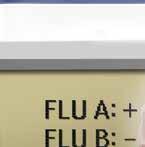


* In the USA, this product has not been FDA cleared or approved but has been authorized by the FDA under an Emergency Use Authorization for use by authorized laboratories; use by laboratories certified under the CLIA, 42 U.S.C. §263a, that meet requirements to perform moderate, high, or waived complexity tests. The product is authorized for use at the Point of Care (POC), i.e., in patient care settings operating under a CLIA Certificate of Waiver, Certificate of Compliance, or Certificate of Accreditation.


This product has been authorized only for the detection of proteins from SARS-CoV-2, influenza A and influenza B, not for any other viruses or pathogens; and, in the USA, the emergency use of this product is only authorized for the duration of the declaration that circumstances exist justifying the authorization of emergency use of in vitro diagnostics for detection and/or diagnosis of COVID 19 under Section 564(b)(1) of the Federal Food, Drug and Cosmetic Act, 21 U.S.C. §360bbb-3(b)(1), unless the declaration is terminated or authorization is revoked sooner.





During the fall and winter months, respiratory syncytial virus (RSV), influenza, and strep are on the rise, and COVID-19 cases have recently been on the rise in the respiratory season mix as well.
“COVID-19 infections and hospitalizations have followed a similar seasonal pattern as influenza. Cases rise throughout the fall, peaking in the winter. As spring arrives, cases decrease, reaching bottom in the summer. This pattern held true for COVID-19 cases in 2020, 2021, 2022, and again this year,” according to Mark Van Sumeren, managing director, Health Industry Advisor, LLC and General Manager, LogicSource, Inc.
To prevent COVID-19 infection, and an infection from other respiratory illnesses during peak season, stay away from people that are sick, and stay up to date with all vaccinations required for the flu and COVID-19. At-risk and immunocompromised individuals should continue to wear a mask and socialize outdoors (where there is more ventilation) during respiratory season if needed.
“Whether the flu or COVID-19, pay close attention to transmission rates in your area. If they are running high, elevate your preventative behavior. Limit close interaction in indoor spaces; if you experience symptoms, avoid contact with others,” said Van Sumeren. “Most importantly, both the flu and COVID-19 disproportionately impact vulnerable citizens
death data and national and countylevel test positivity data (because laboratories are no longer required to report test results after May 11), according to the CDC.
Van Sumeren tracked COVID-19 data during the height of the pandemic to deliver timely and unbiased insight on disease cases. By using statistical measures to tease data, he complied information about where infections were heading in the future. This allowed healthcare leaders and physicians to act in advance and prepare properly to accommodate higher infectious cases.
“I discontinued tracking current COVID-19 cases early in 2023. With cases and hospitalizations trending downward, life had returned (mostly) to normal. As COVID-19 cases and hospitalizations have trended downward, the need for this type of reporting has subsided,” according to Van Sumeren. “The number of hospitalized patients is lower than at any point since the pandemic began and continues to trend downward.”
COVID-19 symptoms include fever, cough, shortness of breath, body aches, loss of taste or smell, and more, according to the CDC. The symptoms of COVID-19 and influenza, RSV, and strep are very similar, and testing is needed to confirm the exact illness and begin disease-specific treatment. During respiratory season especially, it is important for an individual to see a healthcare professional if they exhibit these symptoms so a physician can make a diagnosis and begin proper treatment.
including the elderly, immunocompromised, and those with certain chronic conditions. Protecting these people is critical to their health and to the health of the population,” said Van Sumeren.
The CDC continues to track national COVID-19 hospital admissions, emergency department patient visits with diagnosed COVID-19, and COVID-19 test positivity, among other statistics. Data that is no longer tracked includes COVID-19 national
As the nation moves on from the pandemic, both health systems and public health organizations have learned a lot from the past three years and are more prepared to address the public health burden associated with COVID-19. As the world moves forward from the pandemic, the CDC’s priority is to provide the information necessary to protect the public health of the nation.
“The public is now more aware of the risks of COVID-19 and how to mitigate them. Healthcare systems are better prepared to handle surges in cases. And the data is now more reliable, thanks to the work of public health officials and researchers,” said Van Sumeren.
By using statistical measures to tease data, he complied information about where infections were heading in the future. This allowed healthcare leaders and physicians to act in advance and prepare properly to accommodate higher infectious cases.
Serving US healthcare providers for over 30 years, Dukal offers solutions to protect and manage a comprehensive scope of wound care needs.
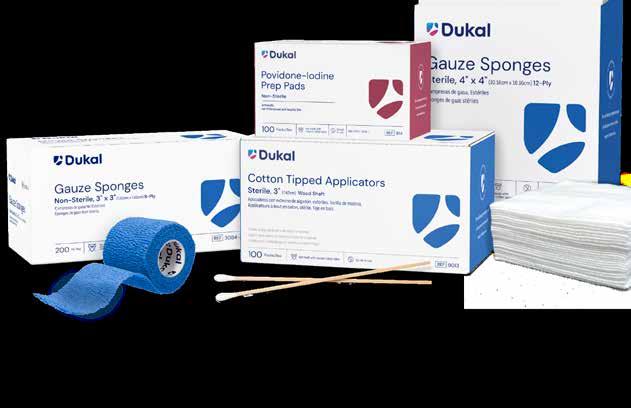
> Antiseptics & cleansing
> Applicators & swabs
> Bandages
> Burn care
> Casting
> Impregnated dressings
> Medical tapes & adhesives
> Small procedure kits
> Wound closure
> Wound dressings
Dukal is working with healthcare professionals around the world in manufacturing and supply chain solutions, to mitigate disruptions that impact business and patient health. Helping you manage everything from product to patient. Because when people have access to better health, they have access to a better future.

> Visit dukal.com to learn more
 Scan with your phone’s camera to view our wound care solutions.
Scan with your phone’s camera to view our wound care solutions.
Physicians are prepping for invasive group A strep cases following an increase among children last season.

Rising pediatric strep cases caused more young children than usual in 2022 to contract a severe group A strep infection. Young children’s immune systems are still developing, and therefore they can be at a higher risk for developing a severe infection from strep.
Streptococcal bacteria causes common and generally mild illnesses such as strep throat and scarlet fever. However, if left untreated, group A strep (iGAS) can progress and become invasive throughout the body. According to the Centers for Disease Control and Prevention (CDC), in the past five years, approximately 14,000 to 25,000 cases of invasive group A Strep have occurred annually, and 1,500 to 2,300 people die each year due to invasive group A strep disease. Severe iGAS infections may lead to life-threatening diseases including pneumonia, necrotizing fasciitis, and streptococcal toxic shock syndrome.
Respiratory illness cases overall decreased during the COVID-19 pandemic. According to the CDC, group A strep cases during the pandemic decreased by nearly 25% in the U.S., with invasive group A strep numbers remaining especially low among children. Recently though, hospitals throughout America and Europe have been experiencing more iGAS cases in children than is typical. According to the Colorado Department of Public Health and Environment, since the 2022 respiratory season, there have been
Physicians are preparing for a busy upcoming respiratory season, as group A strep cases have been on the rise along with other illnesses including RSV, COVID-19, and the flu.
Disease mitigation efforts implemented during the pandemic, such as school and workplace closures, masking, and social distancing may have contributed to lowered respiratory illnesses in previous years. However, now that the nation has been returning to pre-pandemic normalcy, preliminary CDC data indicates that iGAS infection levels in children are increasing earlier in the season than in a typical year. Group A strep cases were higher than pre-pandemic levels in some areas of the country such as Colorado and Minnesota.
According to a CDC study titled “Increase in Pediatric Invasive Group A Streptococcus Infections in Colorado and Minnesota,” most cases (73.5%) that occurred during the recent increase in October through December 2022 were in children and adolescents without underlying medical conditions, which has raised concerns among health professionals.
“At Children’s Hospital of Colorado, we hypothesize several different reasons for the increased number of group A invasive strep cases. The first and likely contributing factor is that an increase in cases came on the heels of our large respiratory viral surge that we had in 2022 and 2023, and our data supports that there is an association between the rise in RSV and flu cases, as well as a subsequent rise in
invasive group A strep cases,” according to Dr. Sam Dominguez, infectious disease specialist at Children’s Hospital Colorado and professor at University of Colorado School of Medicine. Strep is dangerous particularly for young children, because if the disease is left untreated, it can lead to more invasive infections that a child’s developing immune system has difficulty fighting off.
influenza vaccine, variella vaccine, and the COVID-19 vaccine. Getting your vaccines is critically important for prevention of all the respiratory infections they’re targeted against, and they have the benefit of decreasing risk of a secondary bacterial infection as well,” according to Dr. Dominguez.
Parents should monitor children for signs of strep infection including
“Invasive group A strep can present in multiple different ways. With our experience at Children’s Hospital of Colorado in the past six to eight months, parents should pay attention to if children are having trouble breathing or walking, if they are progressively getting worse, and if they have a rapidly spreading rash. These symptoms are indicators of a secondary bacterial infection, and you should bring your child into the hospital quickly,” said Dr. Dominguez.
Health systems are preparing to deal with an increase in severe strep cases in respiratory seasons going forward. During respiratory season, parents should ensure children are washing hands, staying away from people that are sick, and that children are up to date with vaccinations.
“Respiratory viruses are a risk factor for more invasive disease. We strongly encourage everyone in the upcoming flu season to get their
fever, sore throat, trouble swallowing, or children not acting like themselves. Children should see a physician for mild to more severe strep symptoms so that doctors can prescribe antibiotics to clear the infection. There is currently a national shortage of amoxicillin suspension, the liquid antibiotic often prescribed to children to treat group A Strep infection. The American Academy of Pediatrics recommends that children instead take amoxicillin tablets, capsules, or chew tabs, or discuss with a doctor about alternate antibiotic options to treat the infection. Children should take all antibiotics prescribed, even if they start to feel better.
“The most common symptom we think of with group A strep is pharyngitis (sore throat). If your child has a high fever, sore throat, and headache, without accompanying respiratory symptoms, see your primary care provider for medical attention to be treated with antibiotics and to make sure your child doesn’t have group A strep,” said Dr. Dominguez.
There is currently a national shortage of amoxicillin suspension, the liquid antibiotic often prescribed to children to treat group A Strep infection.
Industry stakeholders share what they’ve done to prepare for this year’s respiratory season.
Abbott
Editor’s note: The following responses were provided by Sonal S. Nana, MBA, senior marketing manager, ID NOW™ and Connectivity, Infectious Disease, US Market, Abbott.
Q: In what ways has the industry adjusted to the disruptive nature of the last few respiratory seasons, combined with the pandemic?
Sonal Nana: The pandemic and the last few respiratory seasons have challenged our industry to be as agile as possible in adapting to changes in demand, and to stay current with the evolving needs of clinicians and patients. From a manufacturing perspective, we plan our operations carefully by constantly monitoring surveillance data to ensure we are positioned to adapt if we see changes in prevalence and demand for testing. We’ve also worked to meet the continuously evolving needs of clinicians and patients. The pandemic highlighted challenges in the industry including staffing, speed to isolation, minimizing waiting time for patients, etc., which emphasized
the operational and clinical benefits of bringing molecular point-ofcare testing closer to the patient as it enables results during the patient visit and timely treatment.
Q: How are we better prepared? What work remains to be done to avoid shortages or potential issues?
Nana: We developed many different plans over the past few years to adapt as the seasons continue to evolve. With this knowledge and experience, we are better positioned to pivot to alternative plans quickly to avoid shortages or potential issues, wherever possible. However, we can’t prepare for what we don’t know. Which is why Abbott created the Abbott Pandemic Defense Coalition, the first industry-led global scientific and public health
partnership dedicated to the early detection of and rapid response to future pandemic threats. Together, we’re identifying, tracking, analyzing and testing emerging threats around the globe, including COVID-19 variants so we can best avoid potential future issues.
Q: What sales challenges can Repertoire readers expect to face this respiratory season insofar as in-office diagnostics are concerned? How can reps overcome those challenges?
Nana: One challenge observed the past few years is customer hesitation to prepare for respiratory season with inventory. Repertoire reps can help encourage customers to consider action that can be taken now to stay proactive as we start to see respiratory season start.
Editor’s note: The following responses were provided by Nikos Pavlidis, vice president and general manager for Diagnostics at BD.
Q: In what ways has the industry adjusted to the disruptive nature of the last few respiratory seasons, combined with the pandemic?
Nikos Pavlidis: The pandemic highlighted and accelerated exist-
ing trends in healthcare including the movement of healthcare into new care settings. We’ve witnessed healthcare transition from the hospital room to the living room – and every point in between – to reduce
the higher costs and inefficiencies associated with unnecessary hospital visits by enabling access to care at the most efficient point, including the physician offices, surgery centers and long-term care facilities.
It also accelerated the clinical need and adoption of combination respiratory testing which I firmly believe will be the standard of care moving forward. Combination tests will help eliminate the need for multiple tests or doctor’s visits and will also help to increase testing capacity during the busy flu/RSV season and speed time to diagnosis.
Q: How are we better prepared? What works remains to be done to avoid shortages or potential issues?
Pavlidis: Throughout the pandemic, we learned several lessons on how to prevent shortages and implemented new technology that helps us better anticipate consumer demand. We also introduced a new product track-
ing software that allows us to monitor product delays. Moving forward, we believe these interventions will curtail supply chain issues and help us avoid shortages. Additionally, we plan to expand collaborations with distributors. This will allow us to react quicker through robust integration of our supply chain and increased visibility on our collective inventory position.
Q: What sales challenges can Repertoire readers expect to face this respiratory season insofar
as in-office diagnostics are concerned? How can reps overcome those challenges?
Pavlidis: There is no crystal ball to predict how the upcoming respiratory season will play out. Last year, there was the looming threat of a “tripledemic” with COVID-19, influenza and RSV circulating at the same time. The threat remains for this coming respiratory season and given the overlapping symptoms associated with these highly contagious viruses, rapid and reliable diagnostic testing will be essential.
Editor’s note: The following responses were provided by Jonathan Overbey, head of corporate alliances and channel management, Sekisui Diagnostics
Q: In what ways has the industry adjusted to the disruptive nature of the last few respiratory seasons, combined with the pandemic?
Jonathan Overbey: In general, the industry is communicating and sharing information more frequently than before the pandemic. There is a sense of community and partnership. However, as a manufacturer, we have responded by producing more kits with better dating, we are taking on more risk of building inventory earlier and often
to ensure product is available for spikes in demand.
Q: How are we better prepared? What works remains to be done to avoid shortages or potential issues? Overbey: We are better aware if not better prepared. The work and risk are getting there but more production needs to be done onshore or closer to our shores. We must have more control of our Supply Chain and not return to just in time and lowest cost of measure.
Q: What sales challenges can Repertoire readers expect to face this respiratory season insofar as in-office diagnostics are concerned? How can reps overcome those challenges?
Overbey: Take orders earlier and truly be a consultative sales rep to your customers. There is always a spike in demand, the questions are how big and how much? We strongly suggest a minimum/maximum approach to orders and ordering. Share with your customers what they bought last season and at a minimum stock and buy at least a quarter to half of that amount. You should contact or meet with them more often during the last 4-5 months of the year to check demand and needs.
There is no crystal ball to predict how the upcoming respiratory season will play out.
Take orders earlier and truly be a consultative sales rep to your customers. There is always a spike in demand, the questions are how big and how much?
QuidelOrtho
Editor’s note: The following responses were provided by QuidelOrtho.
Q: In what ways has the industry adjusted to the disruptive nature of the last few respiratory seasons, combined with the pandemic?
Noted adjustments in the industry have included many companies requiring and requesting expeditious review cycles at the FDA for hundreds of COVID-19 tests; better partnerships between the U.S. government and the industry; the expansion of telemedicine and laws to support its use; and near-shoring of critical components and raw materials. QuidelOrtho also anticipates the upcoming respiratory season with tests for Strep, Flu and RSV.
Q: How are we better prepared? What works remains to be done to avoid shortages or potential issues?
We think the industry as a whole is better prepared. The capacity for ramping test volume remains at our manufacturing sites here in the U.S., although utilization has waned in this endemic phase. We are continuing our efforts to optimize our sites and supply chains (what the industry refers to as “warm manufacturing”) to allow our organization to respond very rapidly in the event that a pandemic-like set of circumstances were to reemerge.
Q: What sales challenges can Repertoire readers expect to face this respiratory season insofar as in-office diagnostics are concerned? How can reps overcome those challenges? A few challenges the industry might face:
1. Challenge: In a rapidly evolving environment post-pandemic, understanding changing reimbursements and regulations can be challenging.
Overcome: Reps can stay close with their QuidelOrtho account manager or channel manager who will have the latest information to share and help guide conversations.
customer to get the right product the first time.
4. Challenge: Our customers are facing staffing shortages and are looking for ways to improve operational efficiencies ahead of what we expect to be a busy respiratory season.
Overcome: Reach out to your QuidelOrtho rep on how the
2. Challenge: Helping customers meet their diagnostic testing needs with smaller COVID-19 testing volumes this year.
Overcome: Utilize the broad menu of Sofia® 2 analyzer to expand customers’ testing abilities to other important disease states like RSV, Strep A and Lyme disease.
3. Challenge: With various products available on the market, between rapid antigen and molecular, making the decision on what products to lead with can be a challenge.
Overcome: At QuidelOrtho, we have a wide array of diagnostic options, both rapid and molecular. Leading with QuidelOrtho’s quality, speed, ease of use, reliability and trust allows your
Read Now function works on the Sofia 2 analyzer, which can significantly reduce test processing times, working on bringing more automation and informatics easy-to-use products to the market to help address staffing shortages.
We are continuing our efforts to optimize our sites and supply chains (what the industry refers to as “warm manufacturing”) to allow our organization to respond very rapidly in the event that a pandemic-like set of circumstances were to reemerge.
In the last 10 years or so, social media has transitioned from a platform to keep up with friends and family to an invaluable tool for sales and marketing purposes. It’s a powerful way to connect with your target audience, while also reaching new prospects that you might not have been able to build a relationship with.
Here is a breakdown of the major social media platforms that businesses can use:
Facebook – Where it all started. Facebook was the pioneering social networking platform, giving friends and family members the opportunity to easily reconnect. It’s a great place to connect with customers and talk about what your company offers.
Twitter – Another one of the early platforms, Twitter is a better platform for exchanging information and connecting with your customers one on one.
Instagram – An image and video-based platform, Instagram is a perfect platform for marketing pushes with pictures and video.
LinkedIn – Built for businesses and professionals, LinkedIn is where businesses can leverage their employees as brand ambassadors to talk about what the organization offers to its clients.
TikTok – The newest of the bunch, TikTok is a video-based platform that can be incredibly effective for your business, if used correctly. To be most effective, you need a deep understanding of your brand and your customer base.
Incorporating your social media into your marketing plan will help you to reach customers and prospects right where they are. Make sure to post your content consistently to ensure a steady presence, develop a clear voice that will resonate with your audience and use your analytics to better understand your audience. Social media is a great way to generate leads and engage with your audience, so it’s important to know what kinds of content they are most interested in.
Part of what makes social media such a powerful tool is the immediate accessibility to your customers. Through social media you can respond to customer issues, which will make it easier to build and strengthen relationships with your customers. Hashtags are a powerful way to group your organization with some of the bigger topics that your customers care about.
Through advertising campaigns on social media, you can increase sales for your organization. Brand ambassadors or social media influencers can help to boost the wordof-mouth buzz about your organization and boost sales. Social listening is another process where organizations can take a macro view of what their customers are talking about online.
How can your business leverage social media to generate revenue and attention for your brand? At Share Moving Media we help best in class manufacturers build relationships with 95% of the distribution reps in the US. Please contact us at sadams@sharemovingmedia.com to learn how we can help you gain market share through distribution.
A California report found increased access to primary care can provide several important health benefits.
 By Pete Mercer
By Pete Mercer
For all the recent advances in healthcare, health equity is a growing problem in the United States. The Centers for Disease Control and Prevention (CDC) defines health equity as “the state in which everyone has a fair and just opportunity to attain their highest level of health.” There are several ways to do this, but the most powerful way to push health equity across the country is to increase access to primary care.
According to a recently published survey conducted by the California Health Care Foundation, primary care is intrinsically linked to improved health equity.
Primary care is designed to address the mental and physical health needs of the patient, through oneon-one interactions with a team of health professionals. In fact, these primary care visits are often the first touchpoint for any patient concerns – appointments with primary care physicians can lead to further

coordination across the spectrum of care.
The report found that increased access to primary care can provide several important health benefits: early detection and treatment of conditions, better management of chronic disease, and more complete immunization (especially in recent years). While these benefits are important to anyone looking after their own health, they are especially important for the elderly and economically or socially marginalized groups experiencing high burdens of preventable illness.
The report says, “Better access to primary care ... is associated with improved life expectancy and lower rates of premature mortality in both international comparisons and across regions within the United States. Conversely, communities with fewer primary care physicians per capita experience greater access challenges, fragmented care, and more costly and duplicative health care services. When facing a shortage of primary care providers, patients also experience a higher risk of medical errors and reduced trust in health care providers.”
This study is designed to provide insight to other states like California who are looking to embrace the charge to revitalize and invest in primary care, with the authors calling for a “paradigm shift in our thinking and actions” to ensure that health equity is prioritized. That paradigm shift would require things like recognizing primary care as a common good, embracing the diversity of primary care practice settings, and building accountability for action within the primary care system.
The report included examples of how states can strengthen primary care and advance equity in five areas: community engagement; workforce education and training; clinical practice transformation; payment and spending; and data measurement, collection and reporting.
If any of this is going to be effective, primary care practices need to be adequately resourced and supported by other entities within the community. Primary care is a worthy investment that will pay dividends into our communities, our families, our businesses, and our future.
Creating an interruption-resistant supply chain won’t be easy. But it will be necessary.

No secret here: The COVID–19 pandemic created significant pressures on the global medical supply chain. The Health Industry Distributors Association (HIDA) estimates that in 2021 and 2022, approximately 31,000 to 46,000 containers of critical medical supplies were delayed an average of 29 days throughout the transportation system, says Kathryn DiBitetto, vice president of congressional relations for HIDA.
David Hargraves, senior vice president of supply chain, Premier Inc., says, “Our industry has learned valuable lessons since 2020, and while more work remains, the healthcare supply chain is evolving to be stronger emerging from the pandemic than it was entering it.”
The problem was complicated by the fact that more than half of U.S. imports of COVID-19-critical goods came from only three partners – the People’s Republic of China (30.6%), Mexico (15.3%), and Malaysia (9%), she says. While some countries in which medical supply manufacturing occurs are reliable suppliers and allies, others have adopted or maintained policies that make United States supply less secure.
Major supply chain players are working to build an “interruptionresistant” supply chain. How are they doing?
“Key stakeholders across the supply chain continuum have built redundancy into their procurement and inventory processes, increasing on-hand inventory levels, identifying clinically acceptable alternative products, adjusting utilization and diversifying manufacturing locations,” says Mike Schiller, senior director of supply chain for the Association for Health Care Resource & Materials Management (AHRMM). These collective strategies have transformed the healthcare supply chain from lean and mean to nimble and adaptable.”
Greater communication and collaboration among providers, suppliers and other supply chain stakeholders has already woven risk mitigation efforts and contingency plans into the fabric of everyday supply chain operations, says Hargraves. Provider respondents to Premier’s 2023 Resiliency survey ranked “assessing a supplier’s vulnerability to disruptions” as the most important factor when analyzing supplier risk. “There has definitely been movement on supplier KPIs [key performance indicators], formalized disaster preparedness and response playbooks, enhanced supplier contract terms and conditions, and increasing inventories for critical products.”
Geographic diversification in production and sourcing is another area of progress, adds Hargraves. “One of the most critical lessons we learned is that when we outsource too much of our manufacturing and sourcing capabilities overseas,
Supply chain executives in hospitals and health systems are doing what they can to help prevent future supply chain disruptions, says Mike Schiller, senior director of supply chain for the Association for Health Care Resource & Materials Management (AHRMM).
“Healthcare providers have done a tremendous job adapting to the challenges of the last three years,” he says. “While backorders remain an issue, they are ... not near the extreme levels we saw during the height of the pandemic nor are they at pre-pandemic levels. ’Stay the course’ is my recommendation.”
Providers should continue evaluating utilization practices, risk-stratify inventory to identify “mission critical” supplies, and work with their clinical teams to determine clinically acceptable alternative products, advises Schiller. In addition, they should explore the development of in-house data analytics tools or third-party
we create vulnerabilities for providers and patients here at home. We’re seeing a growing number of supply chain professionals committing some portion of their annual purchasing volume (20% to 30%) to onshore or nearshore sources to help create an appropriate backstop.”
David Mintz, chief supply officer for NDC, believes the U.S. medical supply chain is better equipped today to face a major supply chain disruption due in part to increased inventory in the Strategic National Stockpile (SNS), pandemic-derived capability building, and expanded manufacturing capacities. Before COVID-19, the annual appropriation for SNS was $610 million, he says. Appropriations have grown to $965 million, an increase of 58%.
Providers, distributors and manufacturers have adapted to meet the supply chain challenges such as those associated with the pandemic, adds Mintz. “With COVID-19, demand spiked for certain raw materials, components and finished goods
solutions and the adoption of data standards, including the Unique Device Identifier (UDI) to bring about more accuracy and transparency to procurement transactions, inventory levels and locations. “Lastly, consider how to best incorporate point-of-consumption (utilization) data into your procurement and replenishment activities with the goal of moving toward a demand planning vs. par level environment.”
He suggests that supply chain executives continue to develop strategic relationships with trusted trading partners. ”Providers should work with their supply chain partners to gain upstream visibility into their supply chains, and they should view their individual supply chains as single ‘virtually integrated’ supply chains, and look to expand the scope of that integration to include others.
“Acquire a global acumen and bring that perspective to your supply chain,” he advises supply chain executives.
ranging from pharmaceuticals to PPE to respiratory to cleaning supplies. This sustained increase was significantly higher than many manufacturers had capacity to support. Over the last few years, many of these manufacturers have made investments to increase capacity, resulting in more manufacturers better positioned to support a surge in demand.”
All that said, more work needs to be done, according to those with whom Repertoire spoke.
Better communication needed Linda Rouse O’Neill, senior vice president for supply chain policy, HIDA, believes private industry and federal agencies need to establish strong communication protocols and formalize channels established during the pandemic. “At HIDA’s recent Preparedness Summit, one of our members posed a very astute analogy,” she says. “‘If a burglar breaks into my house, I know to call 911. Who do I call to report a medical supply chain emergency?’
“Private industry receives information every day from around the world about the state of the medical supply chain,” she adds. “If this information were properly channeled and analyzed, it would be valuable to spot trends ahead of a future pandemic. This information would then need to be disseminated to public and private stakeholders in a manner that allows them to make informed decisions.”
The most important action item for the industry is to stay engaged with federal, state and local partners, says O’Neill. “Since last year’s Preparedness Summit, HIDA has been working with federal agencies to stand up a Supply Chain Monitoring Partnership that would serve as an early warning system for the medical supply chain.” Private industry and federal partners would develop criteria to monitor whether the medical supply chain was in a steady state (green), whether potential disruptions and resolutions had been identified (yellow), or if mitigation
efforts were overwhelmed (red). “We will be pushing this out as a resource for all stakeholders this summer.”
“We have a great opportunity as supply chain leaders to keep preparedness top of mind for policymakers,” says DiBitetto. “We are pleased that Congress is working in a bipartisan manner to reauthorize the Pandemic and All Hazards Preparedness Act. Not every public health crisis is a pandemic, and we need to reauthorize this all-hazards preparedness bill without delay.” HIDA executives carried this message to over 80 offices on Capitol Hill during a Washington fly-in this summer.
HIDA supports the creation of a “fast pass” process to expedite medical supplies throughout the nation’s transportation system, she adds. “Such a system would identify containers of medical supplies, prioritize those supplies for container access and sea freight space, and use ‘peel off’ capability for priority handling by ports, rail, and trucking.”
One of the medical industry’s biggest challenges remains a lack of data and transparency around supply availability across the global supply chain, says Hargraves. “We’ve got to get better at understanding product availability and risk – from raw materials to production and distribution locations, to state and national stockpiles, to hospital inventory.
“Think of it this way: Retail hardware stores have apps that tell you the quantity of inventory on hand and exactly what aisle to find it in, but we don’t know how many critical medical supplies or drugs are on U.S. soil at any given time. For providers and suppliers, longitudinal visibility across the supply chain, where entities can see point-of-use information and
resiliency metrics is critical to accurately manage forecasting and supply,” he says. Premier’s PINC AI™ Supply Disruption Manager uses machine-learning models and predictive analytics to predict demand surges and product shortages far in advance with over 90% accuracy, he adds.
Says David Mintz, “From providers to distributors to manufacturers, there is no comprehensive understanding of what inventory resides where. Even during ‘normal’ times, this leads to inefficiencies and product availability issues. During a pandemic or disruption, this is exacerbated along with higher costs to serve.
“If we face another pandemic, we must evaluate its impact on human life and how relevant the vaccines and medical supplies used during COVID-19 will be,” he adds. “Is it a ‘geopolitical’ interruption, impacting the ability to source goods from Asia? Is it a natural event impacting ports or trade lanes for ocean freight, such as the Panama Canal? Is it a cybersecurity event, where the electric power grid is offline for a significant part of the U.S.? In short, multiple scenarios could create supply issues for the medical supply chain. The suddenness, magnitude and duration of the issue will ultimately determine the impact and how quickly continuity of supply can be provided.”
To help mitigate future interruptions, key participants in the industry should consider creating a Control Tower, suggests Mintz. “The first use case could be aligned with a pandemic and the medical products associated with the Strategic National Stockpile. By having improved visibility across the industry, each participant could make better decisions about when to increase/decrease capacity, expedite freight, and expand sourcing and business partnerships.”
NDC supports HIDA in its efforts to strengthen the healthcare supply chain through legislation, he adds. Those efforts include creating a “fast pass” to expedite the transportation of medical supplies, preserving and expanding the PREVENT Pandemics Act to help prepare and respond to existing and new viruses and threats, and establishing a Medical Product Distributor Supply Chain Advisory Group comprising industry and federal partners to identify potential disruptions and solutions.
“With relatively low investment, these initiatives offer the opportunity to increase the availability of medical supplies during pandemics and disruptions. The broader the support among providers, distributors, and manufacturers, the greater the likelihood these important initiatives will be realized.”
Says Hargraves, “It’s important to note that the healthcare supply chain is not immune to current workforce issues and inflationary pressures facing the broader industry. Add to this: We’ve consistently heard from supply chain leaders that ‘unknown supply disruptions with little time to react’ is a core challenge that continues to keep them up at night.”
He urges providers to consider focusing on disaster preparedness and response, and to develop (or update) operational playbooks and best practices on supply chain stability. “Whether it’s 50 pages or five, the most important thing is to document top learnings, critical processes, and opportunities for future success. The delivery of high-quality patient care that comes with effectively managing shortages and supply chain challenges make it worth spending some time to codify what
When processing reusable suction tubes there is the potential for blood and organic debris to clog or block the lumen.







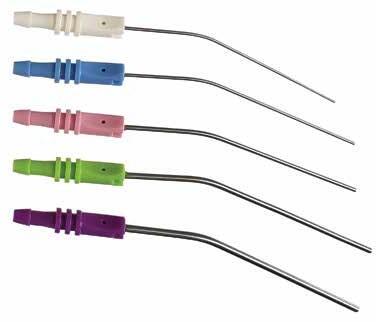


Contaminated tubes create the potential for infection in new patients.
Eliminates cost and difficulty associated with cleaning maintenance and repair of small lumen tubes.

Physician not limited in lumens size or length.

went well over the past year or two, where gaps and challenges remain, and where opportunities for continuous improvement exist.” That could include focusing on the most critical products and categories and identifying clinically appropriate and cost-effective alternatives.
“Overall, innovative solutions to address resiliency, product availability and cost reduction via greater diversity of manufacturing and sup-
pliers, actionable data and technology enablement, and preparedness efforts for disasters and disruptions will be vital to managing supply chain stability in 2023 and beyond,” he says.
Says O’Neill, “The pandemic brought together the healthcare distribution industry and the federal government during a critical time to get life-saving products the last mile to patients. Similarly, the
The pandemic may be over, but work to prevent future supply chain interruptions is not. Here are some developments brewing in the private and public sectors.
In January, Premier released its Advocacy Roadmap for the 118th Congress, which included a call to improve supply chain operations:
Development of an automated supply chain tracking application, which would provide near real-time insight into critical supplies available in the Strategic National Stockpile (SNS) and medical and health supply inventories in communities across the country.
Policies to combat the gray market and ensure supply chain integrity.
Efforts to encourage domestic manufacturing, such as tax incentives, expedited FDA approvals, and favorable Medicare reimbursement for domestically manufactured medical products.
In May 2023, the Food and Drug Administration and Veterans Health Administration announced a joint effort to curb medical device shortages. A pilot project will focus on maintaining supplies of medical devices and accessories that use advanced and distributed manufacturing, such as 3D printing, artificial intelligence, machine learning, and virtual modeling and simulation. In addition, a digital stockpile would store electronic plans, instructions, and methods to make and test innovative medical products.
In June 2023 the Advanced Medical Technology Association (AdvaMed) released its Building Medtech Supply Chain Resilience white paper recommending six priority areas, including:
The immediate and long-term prioritization of medical technology needs for critical components such as semiconductor chips and medical grade packaging.
transportation backlog in late 2021 was another opportunity for collaboration. HIDA worked closely with ports to get medical supplies moving again.
“These relationships must be continually nurtured and renewed for the next public health response. Otherwise, stakeholders will be back where we were in the spring of 2020 – exchanging business cards in the middle of a crisis.”
Greater diversification of supply chains to reduce barriers to the flow of goods and strengthen publicprivate partnerships.
A “fast pass” or “green line” at the national and international levels to expedite the handling of critical medical products and inputs at ports of entry.
Creation of a supply chain coordination office within the U.S. Department of Commerce to work with stakeholders to identify the upstream needs of critical sectors.
In June 2023, the Health Industry Distributors Association held its second Pandemic Preparedness Summit for supply chain executives and federal preparedness officials. Among many topics of discussion, participants agreed that public and private stakeholders should work together to identify producers of critical medical products that have the capacity to meet demand at the start of an emergency. Such a database would be kept up to date to reflect mergers and acquisitions in the industry.
Introduced in May 2023, the Medical and Health Stockpile Accountability Act would require the Administration for Strategic Preparedness and Response (ASPR) to establish an automated supply chain tracking application that provides insight into critical medical supplies across the country.
The Medical Supply Chain Resiliency Act, introduced in June 2023, would allow the president to negotiate with a group of “trusted trading partners” – that is, countries with a “demonstrated commitment to global health security, rule of law and transparency” – to ensure that critical medical goods and services are delivered safely, swiftly and efficiently to patients in the United States and around the world.
McKesson provides a perfect blend of convenient and efficient technology, along with personalized assistance. Our seasoned sales team is dedicated to improving care wherever it’s provided.







A team you can count on
AI is a hot topic in medicine, and its impact on sales is being noticed.

Who’s hasn’t read about the possibilities of AI and natural language processing in medicine, research, even high-school term papers. But what about sales?
“AI-powered systems are on the way to becoming every salesperson’s (and every sales manager’s) indispensable digital assistant,” write the authors of “How Generative AI Will Change Sales,” a recent article in Harvard Business Review, “Sales is well-suited to the capabilities of generative AI models. Selling is interaction and transactionintensive, producing large volumes of data, including text from email chains, audio of phone conversations, and video of personal interactions.
“These are exactly the types of unstructured data the models are designed to work with. The creative and organic nature of selling creates immense opportunities for generative AI to interpret, learn, link, and customize.”
Henry Schein Medical is thinking along the same lines.
“AI can have a number of positive impacts on sales reps and for companies as a whole,” says Bruce Lieberthal, vice president
and chief innovation officer, Henry Schein. “It can help to better understand customers – their purchasing behaviors, their needs, their pain points. It can also help reps enhance their selling time by streamlining the pre-call process, optimizing their routes, and identifying customers that need immediate attention. AI has the potential to help reps focus their time where it will be most impactful – for both them and their customers.

“AI is also likely to help improve processes and maximize resources across other functions as well – not just sales. A few examples include helping optimize pricing strategies, identify the best use of digital channels, and assist with inventory management and demand planning.
All that said, AI will call for some adjustments, he says. “As companies implement more AI technologies into their day-to-day lives, reps will need to embrace the change and adapt to new workflows and ways of connecting with their customers. They will need to understand the WHY behind the AI chosen, HOW to use it most effectively, WHEN to let AI take on some of their administrative tasks, and WHEN to engage with customers directly.”



Microsoft, Salesforce





CRM vendors are jumping into AI for sales. In June 2022, Microsoft Corp. introduced Microsoft Viva Sales, intended to “enrich any CRM system with customer engagement data from Microsoft 365 and Microsoft Teams, and leverage AI to provide personalized recommendations and insights for sellers to be more connected with their customers.”






According to Microsoft, sellers can tag customers in Outlook, Teams or Office applications such as Excel, and Viva Sales will automatically capture it as a customer record. This data can be shared with team members while collaborating in Office and Teams without retyping or looking it up in a CRM. In addition, Viva Sales recommends next steps to progress a customer through the sales funnel and enables sellers to access full history and customer interactions.
Then in March 2023, Salesforce launched Einstein GPT, intended to “infuse Salesforce’s proprietary AI models with generative AI technology from an ecosystem of partners and real-time data from the Salesforce Data Cloud.” Customers can connect that data to OpenAI’s advanced AI models or choose their own external model and use natural-language prompts directly within their Salesforce CRM.
According to Salesforce, Einstein GPT can generate personalized emails for salespeople to send to customers, generate specific responses for customer service professionals to more quickly











answer customer questions, generate targeted content for marketers to increase campaign response rates, and autogenerate code for developers.
Writing in Forbes in March, Pradeep Aradhya, CEO and founder of digital consulting firm Novus Laurus, wrote about the potential as well as the red flags of AI in sales. “I asked ChatGPT to sell me a DSLR camera, and it gave me a list of cameras, their specs, price ranges and even some bounded discounting,” he wrote. “Then I asked it about a particular model and asked it to sell it to me with a specific tone. It actually cross-sold and negotiated with me within preset bounds using Texan expressions. Without any further training from me, ChatGPT knew camera capabilities, specs, pricing and was also able to negotiate and sweeten the deal.”
Despite its upside, sales organizations should proceed with AI prudently, he wrote. “While ChatGPT can offer links, it’s a good idea to restrict it to only produce links from within your domain. It will probably be scary to let technology negotiate either pricing or other perks on your behalf, but I’ve found it can be constrained to preset boundaries. While it will not be easy to feed contextual visitor characteristics and affinities, it is possible.
From there, it is a short step further to feed individual visitor data like click stream or even sales history to further contextualize the chat.
“Even with all of this in mind, it is important to remember that tools like ChatGPT can also have limitations, such as providing false information, wordy or formal answers and information that lacks detail.”
According to the Harvard Business Review authors, “Generative AI must be nonintrusively embedded into sales processes and operations so sales teams can naturally integrate the capabilities into their workflow. Generative AI sometimes draws wrong, biased, or inconsistent conclusions. Although the publicly accessible models are valuable ... the true power for sales teams comes when models are customized and fine-tuned on company-specific data and contexts.”
In May the World Health Organization (WHO) called for caution in using artificial-intelligence-generated large-languagemodel tools (LLMs) such as ChatGPT to protect and promote human well-being, human safety and autonomy, and preserve public health. Precipitous adoption of untested systems could lead to errors by healthcare workers, cause harm to patients, erode trust in AI and thereby undermine or delay the potential long-term benefits and uses of such technologies around the world, says WHO. Serious concerns include:
The data used to train AI may be biased, generating misleading or inaccurate information and pose risks to health, equity and inclusiveness.
LLMs may generate health-related responses that can appear authoritative and plausible to an end user, but that also may be completely incorrect or contain serious errors.
LLMs may be trained on data for which consent may not have been provided for such use, and they mail fail to protect sensitive data (including health data) that a user provides to generate a response.
LLMs can be used to generate and disseminate highly convincing disinformation in the form of text, audio or video content.
WHO reiterated in its statement the importance of applying ethical principles and appropriate governance, as enumerated in its guidance document “Ethics and governance of artificial intelligence for health.” The six core principles identified by WHO are:
Protect autonomy.
Promote human well-being, human safety and the public interest.
Ensure transparency, explainability, and intelligibility.
Foster responsibility and accountability.
Ensure inclusiveness and equity.
Promote AI that is responsive and sustainable.
Source: WHO calls for safe and ethical AI for health, World Health Organization, www.who.int/news/item/16-05-2023-whocalls-for-safe-and-ethical-ai-for-health
‘AI is likely to help improve processes and maximize resources across other functions as well – not just sales.’
Says Lieberthal, “One of the biggest immediate risks would be an overreliance on AI, or the assumption that AI is always smarter than humans. AI develops its models and responses based on the available data and assumes that the data is always complete and accurate. And AI is only as accurate as the data it was trained on. This can lead AI to sometimes make incorrect predictions and suggestions.
“A small example in the sales world might be a recommendation based on a customer’s purchase history. If an item was repeatedly purchased because the customer’s preferred product has been on backorder for several months, AI may recommend something similar to that repeatedly purchased item. In this case, the data does not reveal the customer’s true preferences. Additionally, there are significant concerns regarding AI breaching security protocols and privacy.
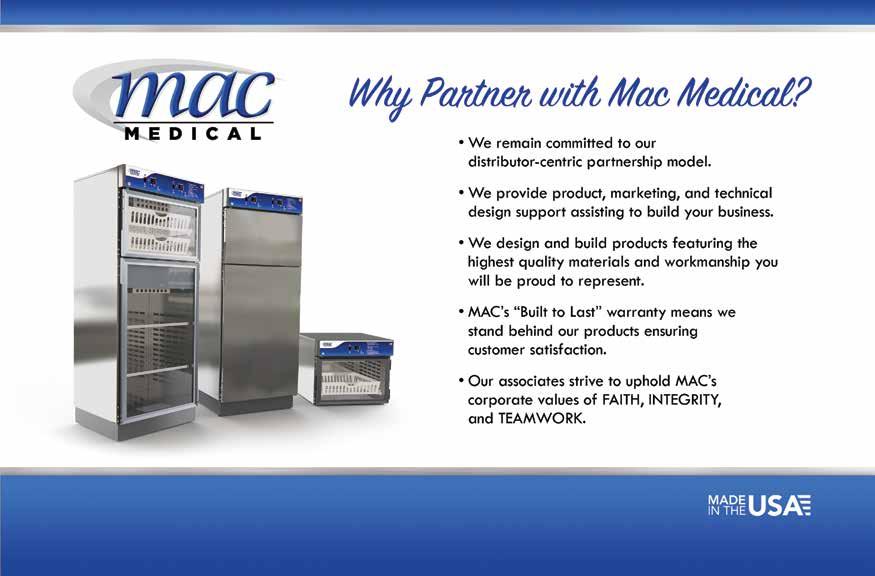
“Although it is possible that AI can improve the ability to service customers, it is not a substitute for the human touch – for the relationship that reps have with customers,” adds Lieberthal. “Even as companies
Further reading:
How Generative AI Will Change Sales, Harvard Business Review , March 31, 2023, https://hbr.org/2023/03/how-generative-ai-willchange-sales#:~:text=Yes%2C%20AI%20will%20 take%20tasks,looming%20massive%20and%20complex%20opportunities

How Tools Like ChatGPT Could Change Sales, Forbes, March 1, 2023 , https://www.forbes.com/sites/ forbesbusinesscouncil/2023/03/01/how-tools-likechatgpt-could-change-sales/?sh=338b384f3e55
begin to implement more and more AI, reps should continue to play a vital role in developing and stewarding relationships with customers. AI will be a collaborator, not a competitor, in this equation, assisting reps and their customers to develop valuable insights and make informed decisions.”
Why the AANP and its new president Stephen Ferrara are advocating for nurse practitioners to have authorization to provide more services.

The American Association of Nurse Practitioners (AANP) recently appointed Stephen A. Ferrara, DNP, as the association’s new president. Ferrara is an actively practicing nurse practitioner with years of experience in a clinical setting and in health policy development. He is currently a member of the senior leadership team at Columbia University’s School of Nursing, serving as the associate dean of clinical affairs and assistant professor. According to a press release announcing his new role, Ferrara will work to lead the organization in advancing the role of the nurse practitioner through healthcare policy, research and innovation, and promoting high-quality patient care. Repertoire Magazine recently spoke to Ferrara about his new term as president of the AANP and how he plans to lead the association.
What do you anticipate will be some of the areas of focus for AANP during your tenure as president?
Stephen Ferrara: As AANP President, I am proud to carry out the mission of our organization, which is to empower all nurse practitioners (NPs) to advance accessible, personcentered, equitable, high-quality health care for diverse communities through practice, education, advocacy, research and leadership. AANP continues to be focused on solutions
that move the health care system forward. There are 355,000 NPs caring for patients in nearly every health care setting across our county. Every day NPs deliver high-quality care to their patients, improving the access, delivery, outcomes and efficiency of our nation’s health care system. Therefore, some of my focus areas will include partnering with stakeholders to diversify the NP workforce and modernize policies that interfere with care.
The AANP advocates for Full Practice Authority. Can you explain to our readers what that is and the importance of it to the delivery of healthcare in the U.S.?
Ferrara: NPs assess patients; order, perform, supervise and interpret diagnostic and laboratory tests; make diagnoses; initiate and manage treatment, including prescribing medication and non-pharmacologic treatments; coordinate care; counsel; and educate patients and their families
The following facts and figures are provided by the AANP on its website. There are more than 355,000 nurse practitioners (NPs) licensed in the U.S. 1
More than 36,000 new NPs completed their academic programs in 2020-2021. 2
88.0% of NPs are certified in an area of primary care, and 70.3% of all NPs deliver primary care. 3
83.2% of full-time NPs are seeing Medicare patients and 81.9% are seeing Medicaid patients. 3
45.6% of full-time NPs hold hospital privileges; 10.9% have long-term care privileges. 3
96.2% of NPs prescribe medications, and those in full-time practice write an average of 21 prescriptions per day. 3
Sources:
1 AANP National Nurse Practitioner Database, 2022.
NPs hold prescriptive privileges, including controlled substances, in all 50 states and D.C.
In 2021, the median base salary for full-time NPs was $113,000. 3
The majority of full-time NPs (56.9%) see three or more patients per hour. 3
NPs have been in practice an average of 9 years. 3
The average age of NPs is 46 years. 3
2 American Association of Colleges of Nursing (AACN). (2022). 2021-2022 Enrollment and Graduations in Baccalaureate and Graduate Programs in Nursing. Washington, DC: AACN.
3 2022 AANP National Nurse Practitioner Workforce Survey — Preliminary Analysis.
and communities. NPs hold prescriptive authority in all 50 states and the District of Columbia (D.C.) and perform more than 1 billion patient visits annually. Currently, 27 states, the D.C. and two U.S. territories have adopted Full Practice Authority (FPA), granting patients full and direct access to NPs and the highquality health care we provide.
It is important to note that FPA is the term used to refer to the licensure laws that authorize NPs to provide these vital services under the exclusive regulation of the state board of nursing. FPA creates greater access to care and more choice for patients and health care systems. FPA also avoids the duplication of services and unnecessary costs.
What do you anticipate legislatively on the federal level to have an impact in the coming years?
Ferrara: NPs are the fastest growing health care provider type in the U.S., and millions of Americans

are choosing NPs for their primary care. Notwithstanding the fact that NPs provide a significant amount of health care to patients across the country, federal barriers still remain that impede timely access to care. We have seen barriers be retired, resulting in
better access to home health care and to medication-assisted treatments for substance use disorders. During the COVID-19 public health emergency, multiple outdated barriers were suspended, which allowed for better access and more efficiency.
As the nation recovers from the pandemic and looks to build a stronger, more effective health care system, we believe the lessons learned over this time will provide a clear road map to modernizing the outdated policies that currently impede patient care.

For example, the Improving Care and Access to Nurses (ICAN) Act has been introduced in the current session of Congress. This critical legislation would improve health care access for Medicare and Medicaid beneficiaries by removing barriers to practice for nurse practitioners and other advanced practice registered nurses. It is important that Medicare and Medicaid beneficiaries have timely access to high-quality care.
What are some of the most pressing challenges nurse practitioners face today?
Ferrara: NPs serve at the intersection of patient care and institutional and health care policies. Every day we see firsthand how inefficiencies
negatively impact our patient’s health, and we are committed to being a solution. Policies that limit NPs from delivering the level of care that they are educated and clinically trained to provide create system challenges, like delays in care, increased administrative burdens, unnecessarily duplicated efforts and increased costs. These challenges lead to clinician burnout and broad health care system ineq-
uity and inefficiency. As health care continues to evolve, it is incumbent upon all of us to enact policies that acknowledge and reflect who is providing care to patients. NPs are a critical solution to health care access and increased efficiency, and we look forward to working with policymakers and health system leadership to ensure patients have access to their chosen health care providers.
The American Association of Nurse Practitioners ® (AANP), the nation’s largest professional membership organization for nurse practitioner (NPs), released the results of a new national survey of U.S. adults conducted in April 2023 that found more than 40% of respondents have experienced a “longer than reasonable” wait for health care. According to the survey, nearly half of those who experienced unreasonable wait times gave up seeking an appointment and did not receive care. This includes patients seeking critical mental health services.
“These results are an eye-opening look at the state of access to care in our health care system,” said AANP President Stephen Ferrara, DNP. “A lack of timely access to care, particularly primary and preventive care, can lead to chronic conditions that put patients’ lives in danger and increase costs. Delayed or deferred care can put an individual’s health at greater risk for complications, which may also lead to a negative impact on mental health and
lost wages for those patients. A decline in productivity for employers may also occur.”
Among those surveyed, 26% reported waiting more than two months to gain access to a health care provider. This situation extends across all major demographics, including age, gender and education, and it impacts access to care in all geographic areas, including rural, suburban and urban settings. Those most likely to give up on seeing a provider after a lengthy wait include younger adults, people living in urban areas and respondents who reported their ethnicity as Hispanic.
“As a nation, we can solve the growing crisis in access to care by modernizing the outdated policies that sideline NPs from delivering care they are educated and clinically prepared to provide,” said AANP Chief Executive Officer Jon Fanning MS, CAE, CNED. “We can help shorten wait times and give patients timely access to the care they need by removing barriers to America’s 355,000 NPs.”




The Centers for Medicare and Medicaid Services (CMS) announced the Making Care Primary (MCP) Model in June 2023 to the national healthcare system. The model’s goal is to provide better health outcomes to people and their communities.

MCP’s primary initiatives are to ensure that patients receive integrated, coordinated, and person-centered primary care, that pathways are created for primary care practices to enter value-based arrangements, and that health outcomes and quality of care is improved nationally.
in eight states. MCP will strengthen the nation’s primary care infrastructure, provide participants with additional revenue to build infrastructure, make primary care services more accessible, and better coordinate care with specialists. These changes will especially benefit small, independent, rural and safety net healthcare organizations.
Through MCP, the Centers for Medicare and Medicaid Services are working toward downstream savings over time by implementing better preventative care services that reduce avoidable costs.
The MCP model aims to improve the quality of care for individuals with Medicaid and Medicare, especially for underserved populations and people in rural areas. The organizational goals of MCP are to improve care management and coordination, partner with community-based
organizations, assist individuals with management of their health conditions, and encourage primary care clinicians to form relationships with healthcare specialists.
The Making Care Primary Model will be tested under the Center for Medicare and Medicaid Innovation
The MCP model will build upon previous primary care models such as the Comprehensive Primary Care (CPC), CPC +, Primary Care First, and the Maryland Primary Care Program (MDPCP) models. MCP will run for 10.5 years from July 1, 2024, to December 31, 2034, and will be tested first in Colorado, Massachusetts, Minnesota, New Jersey, New Mexico, New York, North Carolina, and Washington.
These states will be the first to implement the model into their healthcare systems so they can address care priorities specific to their communities. Priorities include care management for chronic conditions, behavioral health services, and health care access for rural residents.
CMS is working with State Medicaid Agencies in each of the eight states to engage in a thorough healthcare transformation across public programs. In the upcoming future, CMS plans to integrate private funding into the structure of the model.
The model includes a progressive three-track approach based on the practice or participant’s experience level with value-based care models and alternative payment
methods. Participants in all three tracks will receive enhanced payments, with participants in Track One focusing on building infrastructure to support care transformation. In Tracks Two and Three, the model will include advance payments and offer more opportunities for bonus payments based on participant performance. The system will support clinicians with the transition to value-based care.
A relationship between a patient and their primary care team is essential to an individual’s overall health and well-being. Primary care practitioners provide preventative services,
help patients manage chronic conditions, and coordinate care with other clinicians.
Through care integration and increased care management capabilities, primary care physicians will ultimately lower care-related costs. MCP will give teams the resources needed to be better equipped to address the symptoms of chronic diseases. This action aims to lessen the likelihood of emergency department visits and acute care stays nationally.
Through the MCP model, participants will be supported throughout their various levels of experience with value-based care to ensure CMS continues to work to reduce care disparities and drive better patient experience and outcomes.



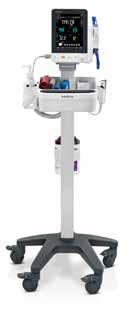
The medical field is constantly changing as private practices continue to merge into larger healthcare systems. Health networks are beneficial because they combine clinical offices, standardize medical procedures, and increase patient care access. However, for physicians that are used to smaller workplaces and the operational structure of private practices, it can be difficult to fit in with the culture of a new, larger company. For many doctors, it is becoming increasingly important post-pandemic to find a position at a practice that is suitable both personally and professionally.
Dr. Lara Hochman, family medicine physician, is the founder of Happy Day Health, a “Medical Matchmaking” company that helps physicians find a career path in medicine that satisfies them. As both an experienced clinician and start-up business owner, she believes in bringing autonomy and joy back into the lives of individuals that work in the medical industry. Through Happy Day Health, Dr. Hochman helps doctors find a career that allows them to rediscover their passion for treating patients.
“As a Medical Matchmaker, I do a lot of work in physician advocacy. I help doctors to find the jobs of their dreams, navigate the job search process, and advocate for themselves during the entire interview and negotiation process,” said Dr. Hochman.
The inspiration for starting Happy Day Health began when Dr. Hochman was working at a private practice that merged into a large hospital system. She witnessed how business operations and administrative tasks can overshadow
patient care within large health networks and decided to come up with a solution for physician burnout related to the industry-wide shift to healthcare networks.

The solution, her consulting business that she started in late 2021, empowers fellow industry physicians to speak up at work and encourages the shift to healthier workplace environments. She believes that when a doctor has a voice to make positive change within the workplace, they can rediscover the motivation that led them to begin working in the medical field in the first place.
Dr. Hochman chose “Happy Day Health” as the name for the consulting business because she “wanted something that was uplifting, and that made people feel good. Thinking about when I personally felt burnt out as a clinician, I used to wake up with a feeling of misery and dread. I want everyone I coach instead to wake up thinking that each day can be a happy day.”
Clinicians that are seeking career advice as a client receive access to current healthcare position openings, they can discuss their personal career goals, practice for job interviews, and receive individualized coaching
on personal and professional development. The goal is to assist clinicians with finding their ideal career, so they are able to be their healthiest self while improving their patient’s clinical experience.
“I’ve never had this strong of an urge to start a business or to be a businessperson. I started the company out of a need to match physicians with employers that will treat them well,” said Dr. Hochman. “This is a huge problem facing the medical industry and I have a potential solution. And I knew I needed to be a part of the solution.”
When Dr. Hochman is working with physicians that reach out seeking career advice, she discusses each individual’s priorities, determines aspects of a medical career that are most important to them, and in many cases, coaches them through the entire process of finding a new job.

Once a client finds a position that interests them, they receive one-on-one training to prepare for the interview process. This includes mock interview practice, so clients feel comfortable answering potential questions. Dr. Hochman encourages doctors to also ask questions of the interviewer so they can understand the company’s culture and be aware of the requirements and expectations of the position before they begin. She also assists clients with advice and strategies to advocate for themselves to negotiate contractual job agreements that work for them.
The extensive Happy Day Health YouTube Channel also guides physicians through the process of healthcare industry career changes by answering job seeker’s frequently asked questions. Numerous videos
narrated by Dr. Hochman include topics such as “How to Effectively Search for Physician Jobs: Tips and Strategies,” “Deciding Between Multiple Job Offers,” and “The Role of Time in Decision Making.” The videos prepare clients for coaching calls and provide them with detailed job search related information.
If a physician already has a job, and is seeking coaching related to their current position, they can meet with Dr. Hochman periodically to make changes in their current position and learn how to advocate for themselves.
“Physicians are in short supply, and we have more power as individuals than we realize. It is not a failure to change jobs, it is not a failure to change from one type of practice to another. It is so important that we take care of ourselves and that we are able to take care of our families, and if you need to make a change, that’s fine,” said Dr. Hochman.
Many doctors are currently feeling burnt out and stressed due to
healthcare industry changes because of the COVID-19 pandemic. Since beginning Happy Day Health at the end of 2021, Dr. Hochman has navigated opening a business during the height of the pandemic and has realized just how needed the company’s services are. Her career coaching model addresses a critical need in the lives of clinicians.
“I started the business with a vision of how I’d like to make a positive change in the healthcare environment for physicians. My vision for the future is to make a big positive impact on the healthcare industry in the way of physicians being able to enjoy practicing medicine without burning out,” said Dr. Hochman. “I want physicians to feel valued by their employers and the patients, and for doctors to be able to practice good medicine.”
Going forward, Dr. Hochman’s goal is to continue to connect physicians with better jobs and healthier lifestyles that allow for work-life balance. This includes efforts from healthcare industry leaders as well. Healthcare administrators should actively listen to their physicians and their teams. Physicians often suggest workplace well-being improvements that are not unreasonable. Small changes brought to the leadership’s attention have the potential to make the workplace more productive overall and allow doctors to provide better patient care.
“As physicians, we are trained so well that when we come out of our training, we know exactly what we’re doing. And then the business aspect is the complete opposite, you figure it out as you go along, there is not necessarily one correct next step. I would say let go of the fear that you may not make the correct decision and just do it,” said Dr. Hochman.
Physicians that come to Dr. Hochman for coaching often are individuals that truly enjoy the practice of medicine but are overworked and unsatisfied with their current position or workplace environment. Physicians seeking assistance in the workplace often do so because of technologyrelated administrative burdens that cause extra workplace stress. Doctors are spending less time taking care of patients and more time than ever on operational tasks to keep the practice running.
Other issues facing the medical profession include physician-owned practices having trouble finding doctors to staff their practices, and in turn, doctors are increasingly unable to find employers that will treat them well. Also, decreasing reimbursement rates from insurance companies prevent physicians from having the time they need to tend to patients in the best way, and visit times must be shortened to cover overhead.
“A lot of times, the physicians that come to me are completely burnt out. Often, I hear from doctors that they love the practice of medicine but are pretty much ready to leave because of the administrative burden, lack of support, and the inability to practice medicine without all the extra hoops that we as physicians have to jump through,” said Dr. Hochman. “In that process, I help them to find jobs that will treat them better so they’re happier, they get to enjoy practicing medicine again, and they can have a voice in the practice.”
Dr. Hochman recommends to physicians that find themselves in a workplace that has organizational challenges to approach administration as a group. Hospital administrators at times delegate too much work
to doctors or have unrealistic expectations for teams, and physicians can be unsure of how to voice their concerns to make needed changes. Coming together as a group to approach healthcare leaders empowers physicians while encouraging administration to take action and work toward a healthier clinical environment.
If a physician feels they cannot manage the challenges presented in their current practice and that their mental health and well-being is impacted by their job, it is important to begin the process of finding a healthier workplace that is a better fit.

Physicians come to Dr. Hochman for a variety of reasons, but ultimately seek help hoping to reset
and find a healthier balance between their personal and professional life.
“Through the process of Medical Matchmaking, when I help physicians to find jobs that treat them better, they are happier, they actually enjoy practicing medicine again and having a voice within the practice,” said Dr. Hochman.
The most fulfilling part of her work as a physician and business leader is creating a change in people’s lives for the better, she says, “In medicine, I get to help guide people to their health goals.
As the Medical Matchmaker, I get to guide people to better lives so they can enjoy their spouses and their kids.”
COVID taught us that we can create leads through 2 minute videos
Videos added monthly

Can be sent from the app in seconds


Increase sales
86%
78% of marketing professionals reported that they used video as a marketing tool.*
of those marketers felt videos have directly increased sales for their business.*
Advantus Health Partners works to ensure clinical validation of key products and services, waste reduction and standardization of major product categories as solutions beyond traditional supply chain GPO management. Launched in 2021 by Cincinnati-based Bon Secours Mercy Health, one of the 20 largest health systems in the U.S., Advantus is led by healthcare professionals and providers with an aim to modernize and create more efficient operations between the supply chain and clinical sides.
Dr. Jimmy Chung is its chief medical officer.

“The big crisis in healthcare is that current spending is unsustainable,” Dr. Chung said. “The U.S. spends twice what similar countries spend on healthcare, and much of that has to do with waste and variability in how we practice in the U.S. and the resources we utilize in supply chain.”
To help address this crisis, one business model for Advantus reduces the unnecessary variability in clinical care delivery.
As Dr. Chung puts it, if there are 20 different vendors for orthopedic implants at a hospital, then that’s 20 different ways of doing the surgery, and that leads to mistakes and errors that could harm the patient, while creating operational inefficiency and waste.
He has studied data over the past 10 years that suggests there are opportunities to standardize healthcare purchasing to reduce this variability, and patient risk and supply chain can become a strategic driver in it, playing a critical role in patient outcomes.
Advantus delivers products that have been vetted for quality and value, but physician preference isn’t a part of the equation. Clear expectations are set with physicians that
their feedback will be used when procuring products, but not on a preference basis.
“We don’t have 20 different brands we’re offering through our contracting or GPO portfolio,” Dr. Chung said. “We want to vet what we believe delivers the highest value in patient outcomes and cost. That’s how we want to engage clinicians into our supply chain model.”
Dr. Chung added that they don’t believe physician preference adds value.
“Variability should only be accepted in cases where a necessary need must be considered like a unique patient or research,” he said. “A true clinical need has to be demonstrated before we go off contract.”
Dr. Chung says health systems are steering conversations more toward standardization and best patient outcomes. But supply chains still struggle to be heard as strategic drivers in a lot of hospitals.
“We’re thankful for organizations like AHRMM and SMI that are focusing on reducing waste and variability. There are huge clinical integration components at work with those organizations,” Dr. Chung added. “It’s about spreading the message to hospital executives and C-suites that supply chain needs to be at the table, and in order to do that, it needs to gain legitimacy.”
For example, SMI, a nonprofit community of providers and industry partner organizations, has released a new tool to measure the criticality of products to help create a more resilient supply chain. It’s an enhancement to SMI’s Resilience Maturity Model that was released in 2022.
The Critical Product Attributes Framework provides a common structure and language for healthcare organizations to identify the criticality of products they need in times of crisis. It aims to standardize the process of defining product critically and ultimately aid in providing better patient care. SMI’s Physician Advisory Council provided intelligence and insights included in the tool. The new tool:
Provides a structure for identifying the criticality of products using a common language.
Allows trading partners to have clear conversations about product criticality.
Supports the broad use of the Resilience Maturity Model to drive a more resilient supply chain designed to meet future demands.
The COVID-19 pandemic brought supply chain to the forefront of healthcare. Physicians never had to worry about allocating masks before the pandemic, for example, but they helped administer protocols and appropriate utilizations for N95 masks during the crisis.
“Hospitals realized that bringing in physicians could be useful for supply chains as a whole, so you see roles like medical director of supply chain becoming more popular,” Dr. Chung said. “Many of the hospitals with strong supply chains now have a medical director or physician advisor in place.”
Those medical directors like Dr. Chung must communicate clearly with physicians about product changes and variability reductions. Most physicians easily adjust, but a small percentage might have genuine concerns.
“They might not be convinced it’s a better product, or they aren’t
comfortable with it,” he said. “And there aren’t any incentives for surgeons to seek ways for surgeries to be done the same way.”
Standardization in surgeries would reduce errors and inefficiencies.
“There’s a lot of opportunity in the medical profession to have these conversations, but it’s not happening at that level because physicians aren’t trained in that area,” he said. “We’re still using an apprenticeship type of model. Being unique and doing things your own way is still valued in surgical circles.”
But patients are at risk for different outcomes if the same surgery is done in different ways. Some will have worse outcomes than others or some might have a longer length of stay. Hospital leadership is seeking better standardizations to solve these problems so outcomes can become more predictable.
“And if physicians aren’t driving that conversation, supply chain can start the dialogue,” Dr. Chung said. “We’re all aligned on the social determinants of health, sustainability, and the current healthcare crisis. Let’s start with that.”
Then, Dr. Chung says, supply chain and physicians can work on a common plane together. Reducing variability, for example, can be done if it’s demonstrated that a pared down number of vendors provide more value to physicians and patients downstream.
“There’s so much variability that it’s impossible for a patient to feel like they’re making an informed decision when they’re facing surgery. They have to put their faith in word of mouth and assume that it will lead to a good outcome,” Dr. Chung said.
Proper sleep is critical to maintaining overall health and well-being.
A bad night of rest can impact an individual’s entire day and lead to irritability, fatigue, and reduced alertness. Sleep is an integral part of staying healthy. During the sleep cycle, the body works to support healthy brain function and maintain physical health.
Sleep needs can vary based on the individual. Most adults aged 18 to 64 need seven to nine hours of sleep, with children and teenagers needing much more (eight to ten hours), according to the Cleveland Clinic.
Long-term improper sleep can cause detrimental health impacts and chronic disease. Sleep deprivation has been associated with illnesses such as hypertension, diabetes, depression, heart disease, and improper hormone fluctuation, according to the National Institutes of Health (NIH).
Individuals with sleep disorders have difficulty falling or staying asleep. According to ChristianaCare’s Regional Healthcare System based in Delaware and Maryland, more than 70 million Americans suffer from sleep-related problems.
The body cycles through two phases of sleep each night, rapid eye movement (REM) and non-rapid eye movement (NREM). These stages repeat approximately four to six times throughout each night of sleep. Each stage of sleep includes variations in muscle tone, brain
wave patterns, and eye movements, according to the National Library of Medicine. If sleep is impacted, then an individual does not go through as many of these cycles.
“Sleep issues in the U.S. are worsening. This stems from technology and our habits that contribute to insomnia, the obesity epidemic that has increased the prevalence of sleep apnea, and the new understanding that sleep is important to our overall health and wellness,” according to Dr. Shilpa Kauta, medical director of the ChristianaCare Sleep Wellness

Center. “More people are identifying and recognizing sleep issues on their own and then seeking help.”
To address the growing issue of sleep-related problems, ChristianaCare opened the Sleep Wellness Center on the ChristianaCare Newark Campus in Newark, Delaware in early 2023.
The ChristianaCare Sleep Wellness Center is an outpatient clinical office that provides diagnoses and treatment options for sleep disorders. The facility, accredited by the American Academy of Sleep Medicine, incorporates clinical care and diagnostic testing with a sleep-related medical focus.
The ChristianaCare Sleep Wellness Center provides multidisciplinary diagnoses for sleep-related diseases. Diagnoses are followed with care and treatment from sleep-wellness expert clinicians. Patients who come in for treatment participate in a physical examination, a medical background check, and a personal sleep history analysis.
The physicians and staff at the Sleep Wellness Center integrate sleep services into disease-based programs such as cardiac care, weight loss surgery, and renal transplant care to ensure patients are receiving proper rest after undergoing invasive procedures.
“Sleep disorders affect members of every race, socioeconomic class and age group, but despite the high prevalence of sleep disorders, many people remain undiagnosed and untreated,” said Dr. Kauta.
Even though sleep wellness is such an important indicator of health, national surveys from the National Academies of Sciences, Engineering, and Medicine show that more than 60% of adults have
never been asked about the quality of their sleep by a physician.
“Our goal is to simplify sleep care across ChristianaCare and through our community. Navigating sleep care can be complicated. As a centralized sleep location that collaborates with other programs in our community, we can help coordinate and personalize each patient’s care plan,” said Dr. Kauta.
sleep apnea, restless leg syndrome, and narcolepsy.
“There is a growing need for sleep care centers here in Delaware and nationally. The need for sleep care is related to both an increased awareness of the importance of sleep and a growing population of patients with sleep disorders,” said Dr. Kauta.
Sleep deprivation has enormous impacts on the American economy,
Many causes contribute to sleep deprivation, including longer working hours, lifestyle changes, shift work, access to phones and TV, medications, aging, and more, according to the National Library of Medicine.
“Sleep impacts multiple areas of our health. It affects how you feel during the day. Poor sleep can cause you to feel tired, sleepy, and mentally sluggish and can affect your mood. It can also affect your risk for other conditions like stroke, heart attack and dementia,” said Dr. Kauta.
The need for Sleep Wellness Centers in the Delaware area and across the nation is great. Of the 70 million Americans suffering from sleep-related problems, more than 50% are likely to have a chronic disorder such as insomnia, obstructive
and untreated sleep disorders are estimated to cost over $100 billion annually in lost productivity, medical expenses, sick leave, and property and environmental damage, according to the NIH.
Physicians at the Sleep Wellness Center and doctors with a specialization in sleep disorders can assist patients with diagnoses by treating the underlying diseases that may be impacting sleep quality. Physicians can also guide patients through lifestyle and behavioral changes that can help them to get a better night’s rest.
“After a patient is diagnosed with a sleep disorder, it is important for them to talk to a healthcare provider about their options and the risks of the disorder so that they can receive treatment that addresses the specific needs of the individual,” said Dr. Kauta.
“Sleep issues in the U.S. are worsening. This stems from technology and our habits that contribute to insomnia, the obesity epidemic that has increased the prevalence of sleep apnea, and the new understanding that sleep is important to our overall health and wellness.”
— Dr. Shilpa Kauta, medical director, ChristianaCare Sleep Wellness Center
 Christina Lavoie, Director of Policy, Health Industry Distributors Association
Christina Lavoie, Director of Policy, Health Industry Distributors Association
Ethylene oxide (EtO) is a colorless gas used to sterilize equipment and devices that cannot be sterilized by steam. It is often the most effective sterilizing agent for devices that have many packaging layers or hard-to-reach areas.
Approximately 50% of all medical devices are sterilized with EtO. This amounts to more than 20 billion devices annually. Surgical kits, pacemakers, heart valves, and syringes are among the medical products that rely upon EtO sterilization. For many medical devices, EtO is the only sterilization method that does not damage a device during the sterilization process.
In regulatory comment to the EPA, HIDA has cautioned that any changes to EtO policies must include a realistic and feasible plan to address potential product disruptions and patient care. Disruption at even a single sterilization facility can have a magnified impact across the country as devices sterilized in one facility support patient care in all 50 states. This would have tremendous negative impacts on the medical supply chain.
HIDA is not the only voice raising concerns about pending regulations on medical sterilization:
Food And Drug Administration: FDA Commissioner Robert M. Califf testified before the House Energy & Commerce Committee, and expressed concerns about the EPA’s approach to EtO. Commissioner Califf warned that “a sudden restriction [in the use of EtO] would create substantial difficulty with critical medical devices. … I wish I could say there’s a ready alternative [to EtO sterilization] in a short period of time. There’s not.”
Small Businesses: In its comments on EtO regulation, the
Small Business Administration warned that “these actions would lead to a significant number of small entities leaving the market for commercial sterilization, and hurting patients needing sterilized medical devices.”
Hospitals And Providers: The American Hospital Association cautioned that “moving too quickly to implement and enforce new standards will result in the unexpected consequence of reducing EtO sterilization capacity, ultimately leading to delays in patient care.”
Healthcare distributors want to protect public health. In order to do so, they must be able to deliver sterile critical medical products to providers without interruption in the supply chain. Commercial sterilization facilities play a vital role in maintaining an adequate supply of medical devices.
HIDA continues to monitor the regulatory rulemaking process and advocate for common-sense regulations that ensure patients and providers have reliable access to safe, sterilized medical products.
derived from extensive phone and online interviews with laboratory testing professionals in hospitals in the U.S. These reports present an independent analysis of service trends in laboratory diagnostics and include manufacturer ratings for each instrument type. This wave of the 2023 ServiceTrak™ Clinical Laboratory Awards are based on interviews conducted in 2023 with respondents in over 1,300 clinical testing locations having 1,554 instruments. These numbers are reflective of hematology systems and coagulation analyzers only.
DETECTO has announced
Henry Schein Medical has received the 2023 Supplier Legacy Award from Premier, Inc., a leading health care improvement and technology company that unites an alliance of more than 4,400 U.S. hospitals and health systems and approximately 250,000 other providers and organizations. One of 11 suppliers to receive the award this year, Henry Schein Medical was recognized for its long-standing support of Premier members through exceptional local customer service and engagement, value creation through clinical excellence, and commitment to helping health care providers realize cost savings and efficiencies. Supplier Legacy Award winners have a tenure of more than three years as a Premier contracted supplier.

Sysmex America has received three 2023 IMV ServiceTrak™ Clinical Laboratory Awards for its hematology systems – best customer satisfaction, best system performance and best OEM service performance. IMV, part of Science and Medicine Group, is the leading market research and business intelligence provider to the laboratory diagnostic industry. IMV produces an annual series of proprietary ServiceTrak™ Clinical Laboratory reports
Maryellen Cullity as the new Vice-President of Sales for DETECTO domestic healthcare and foodservice products. Cullity brings more than 25 years of experience in both distribution and manufacturer sales focusing on the entire continuum of care. She has worked in sales management for both major and midsize medical distributors and manufacturer rep groups with a track record of sales growth. Cullity holds a Bachelor of Business Administration from Bryant College. She has previously served as the chairperson and co-chairperson for the Physician Advisory Council of HIDA.

Midmark announced Matthew Logan as Vice President, Marketing. In this role, Logan will help create and shape strategies that will expand and amplify the company’s standing as the industry leader in improving the experience between the patient and the caregiver at the point of care.

Logan comes to Midmark after a successful stint as Vice President of Marketing at Roche Diagnostics Corporation, which develops and produces medical tests and digital tools to help healthcare professionals find the right treatment for patients. Collaborating across sales, marketing, implementation and customer service functions, he spearheaded the creation of a new end-to-end process for the launch of the next generation of connected diagnostic devices and IT solutions. He was also instrumental in helping the company create a competitive advantage through the customer experience.
Sekisui Diagnostics has announced that Luke Christensen has joined the company as the Global Vice President of Sales. Christensen will be responsible for managing the IVD business sales as well as having shared responsibility for portions of the diagnostic enzyme sales ensuring the successful execution of the company’s sales strategy and for managing the budget for his areas of responsibility. Christensen brings with him over 20 years of sales experience as a leader with a solid history of growth and active participation in advancing the interests of Laboratory based businesses. His career began at McKesson Medical-Surgical in Customer Service and then shifted into Sales where he started as a local Account Manager and progressed to an Area Sales Manager. Following his Area Sales Manager assignment, Luke was promoted in 2014 to Vice President, Laboratory Sales – Primary Care. During his time in this role he grew his team from 8 to 35 laboratory sales professionals and helped double McKesson’s business in this area to $1.2B annually.
HIDA has welcomed seven new leaders in healthcare distribution to the Board of Directors. The new members of the HIDA Board of Directors are as follows:
ʯ Emily Berlin; Cardinal Health
ʯ Mark Henderson; Concordance Healthcare Solutions
ʯ Brent Melancon; Owens & Minor
ʯ Kelley Moffett; Cardinal Health
ʯ Ben Nichols; W.W. Grainger, Inc.
ʯ Jack Stephens; NDC
ʯ Emily Wilburn; Wilburn Medical
These new members join the current members of the HIDA Board of Directors:
ʯ Cara Skowronski; Delasco
ʯ Brad Hilton; McKesson Medical-Surgical
ʯ Joel Treffert; Direct Supply
ʯ Alex Caldwell; Claflin Company
ʯ Michael Dubose; Thermo Fisher Scientific
ʯ Bill Abrams; Medline
ʯ Brad Connett; Henry Schein
ʯ Chris Fagnani; Lynn Medical
ʯ David Klarner; TwinMed

ʯ Bill McLaughlin, Jr; IMCO
ʯ KC Meleski; CME Corp
ʯ Randy Reichenbach; Medical Resources
ʯ Joe Reubel; Kerma Medical
ʯ Matt Rowen; HIDA
ʯ Todd Ross; Preferred Medical
ʯ Jay Stevens; The Stevens Company
ʯ Scott Williams; GroveMed
MedPro names Geri Lamano as National Director of Medical Equipment Sales
MedPro announced that Geri Lamano has joined the company as National Director of Medical Equipment Sales. Lamano will be joining the senior leadership team and providing the MedPro sales team with support on expanding the equipment product portfolio, as well as developing new equipment product lines. Lamano brings years of experience, dedication and passion in equipment and furniture sales serving the entire continuum of care with focus in Acute, Non-Acute, Long-Term, Ambulatory and Government care. She boasts an outstanding career in healthcare distribution, most recently as National Director of Equipment and Furniture Sales and Services with Concordance Healthcare Solutions. Prior to that she was with MMS, a Medical Supply Company, for 10 years, and was also a member of team Henry Schein from 1996-2006. Lamano is a Charter Member of Professional Women in Healthcare, currently serving as Vice Chair of Membership with a focus on national and regional events. Geri is a career-long active and dedicated member of HIDA.

Watch
Heart disease is the leading cause of death in the US. 1 That’s why early detection is not only important—it can save lives. The Midmark Digital ECG brings the patient, provider and EMR together at the front line of care.

EMR Connectivity
Works seamlessly with today’s top EMR systems
Workflow
See data, test and store reports in one place

Signal Strength
Capture high-quality cardiac waveforms





